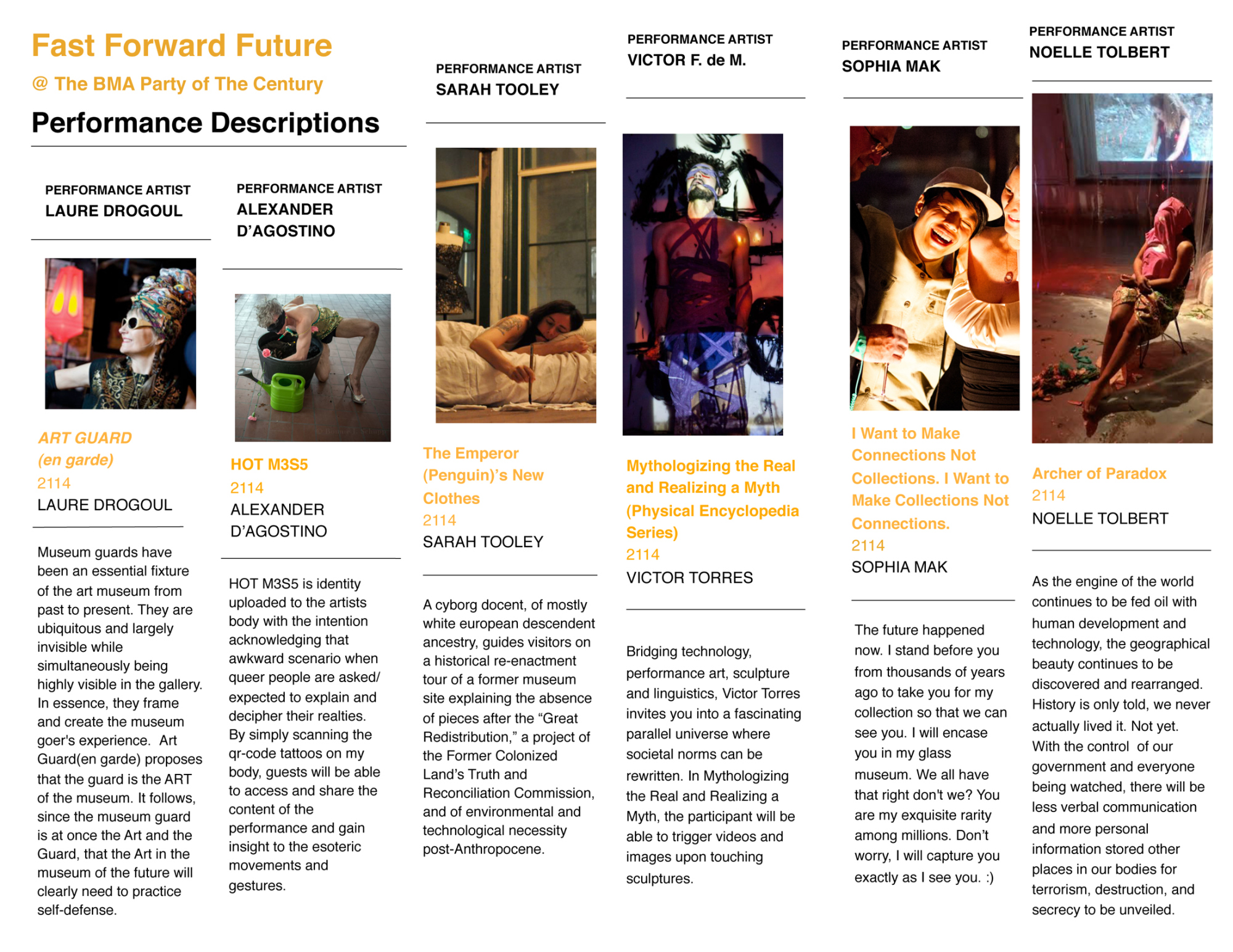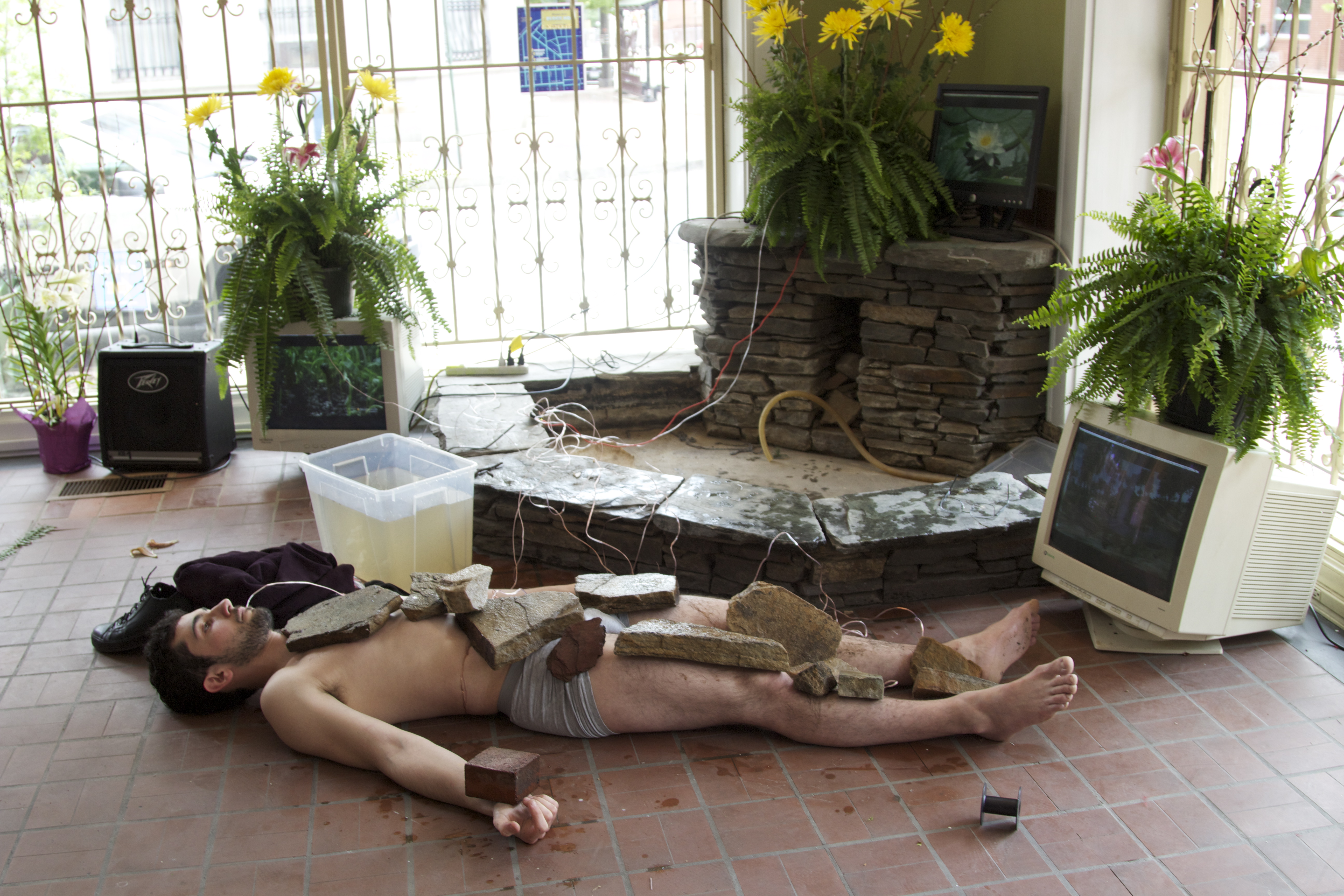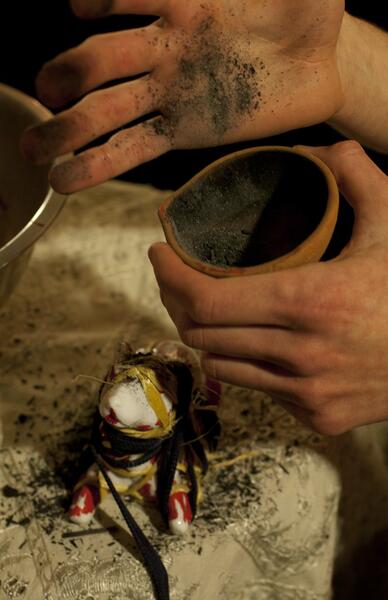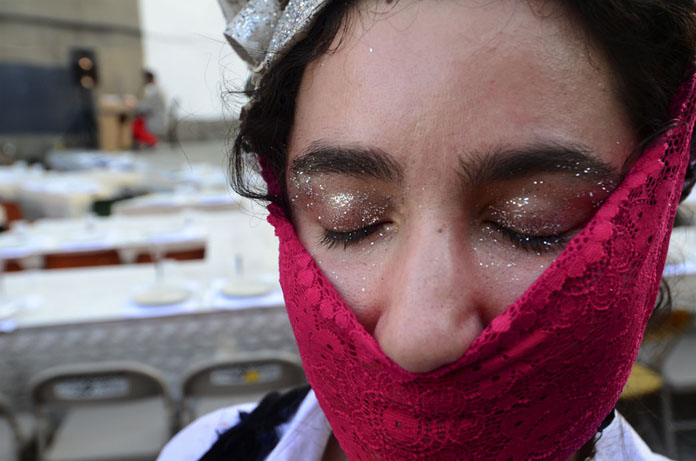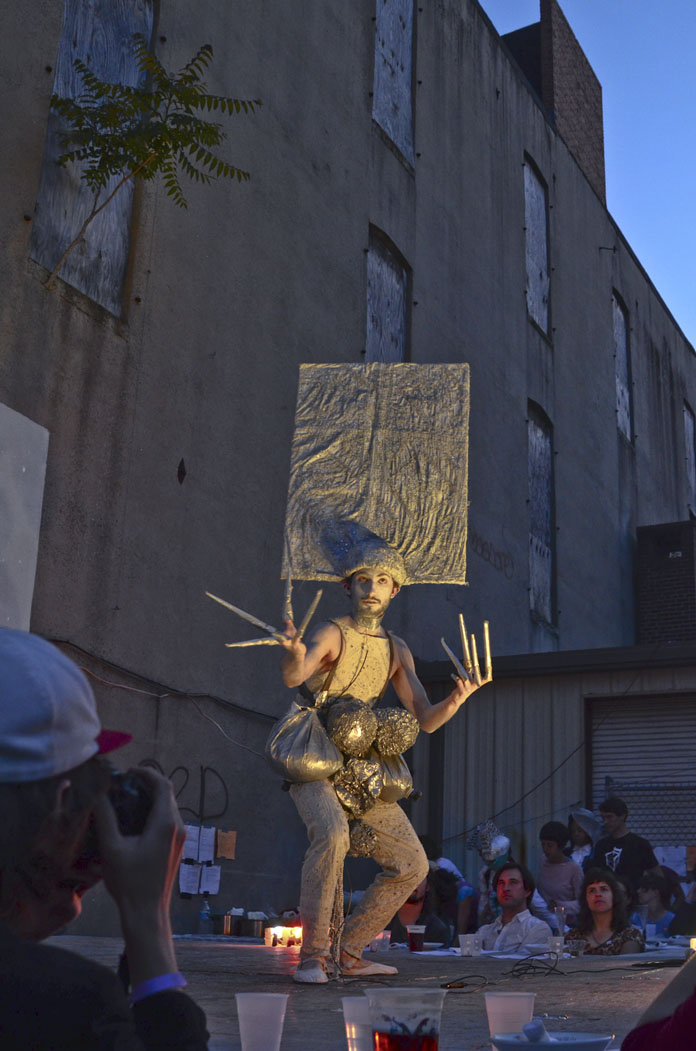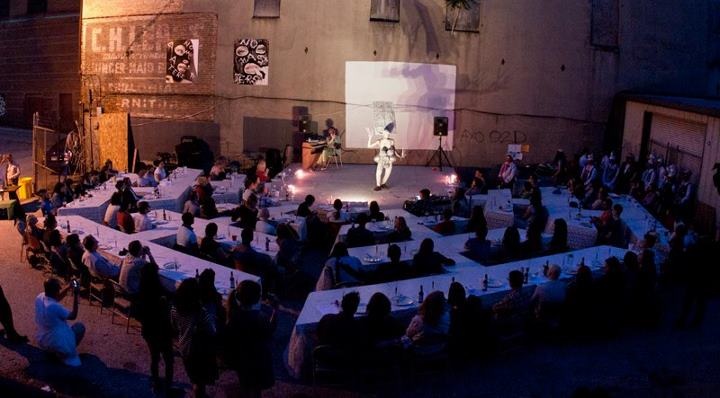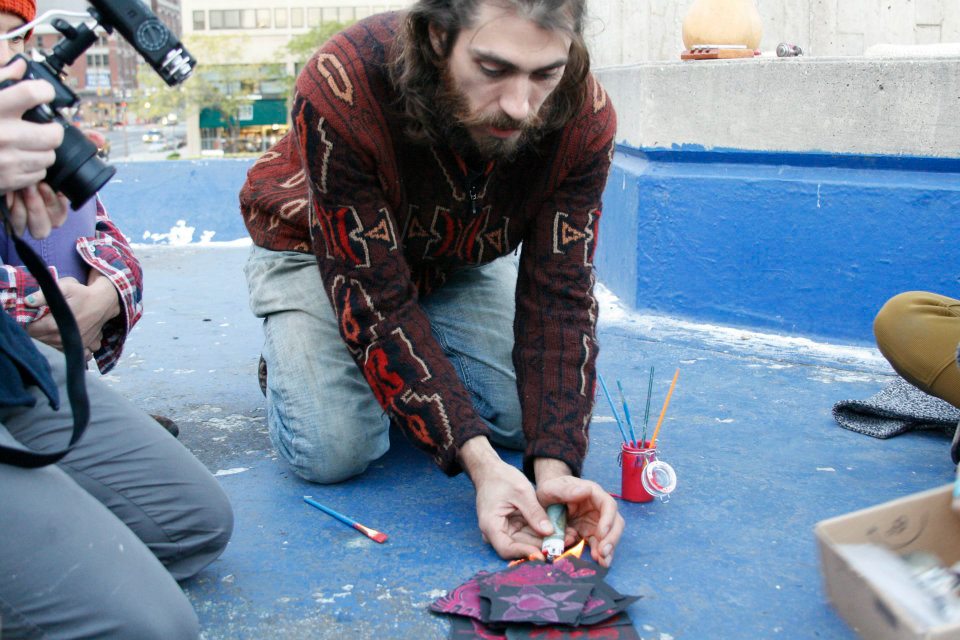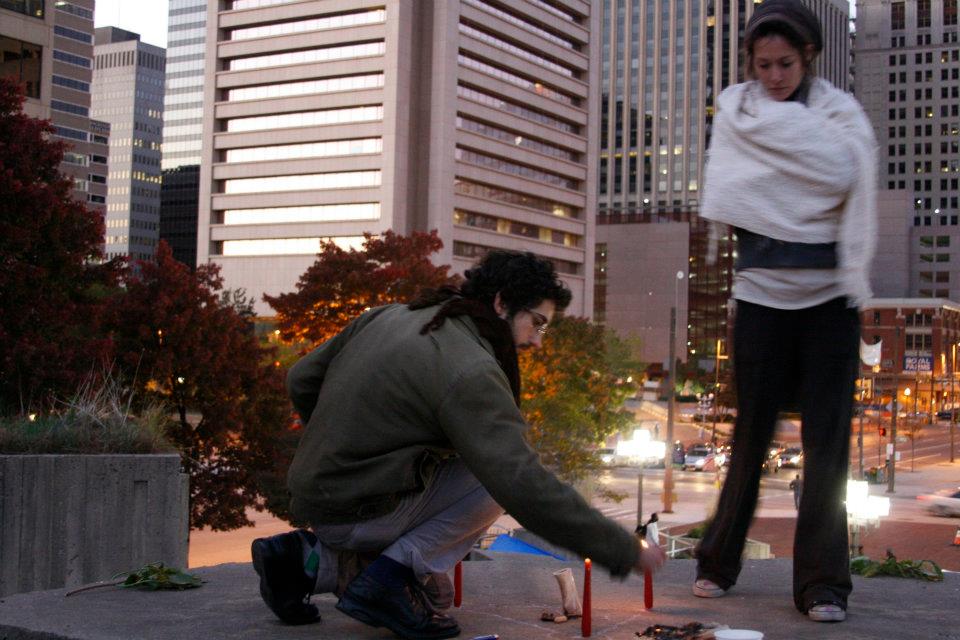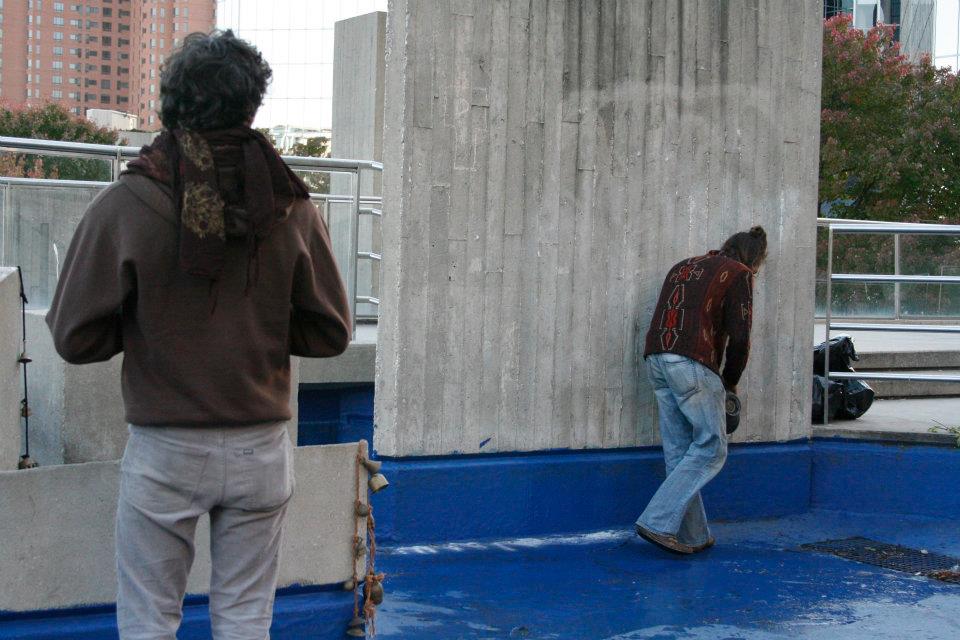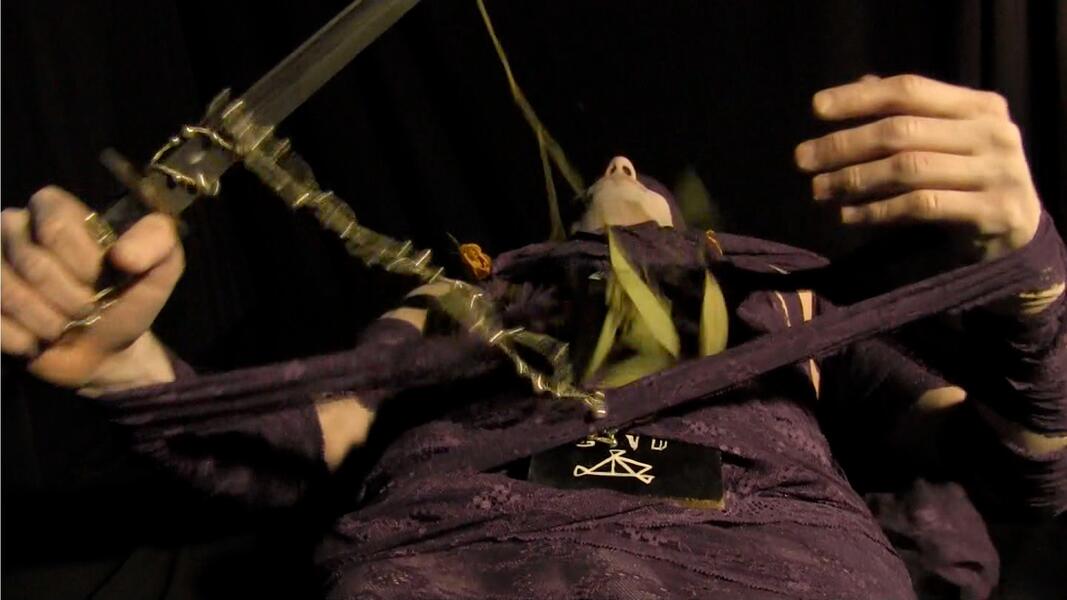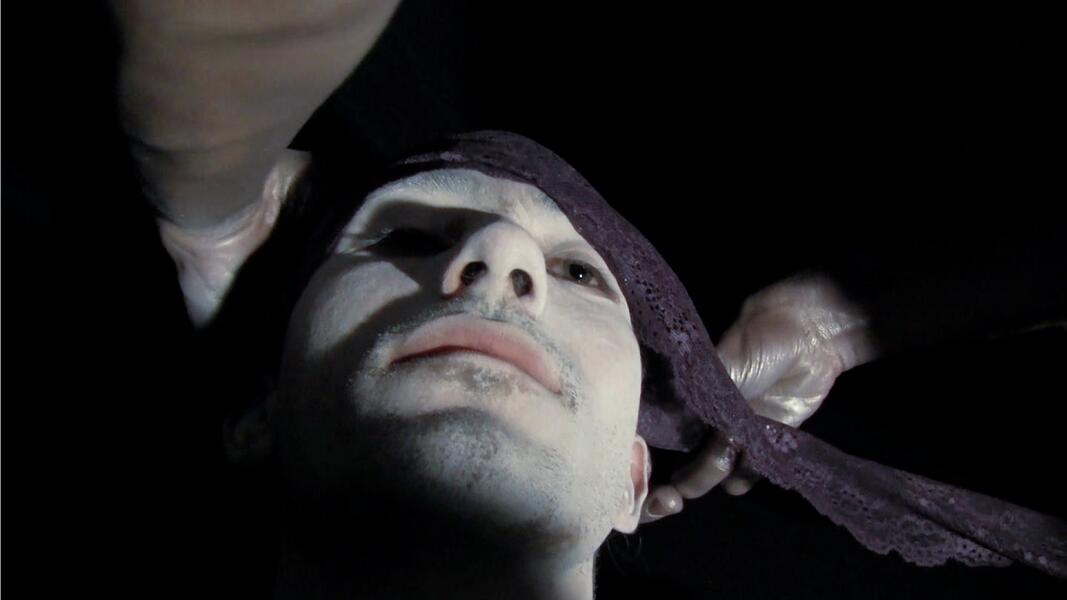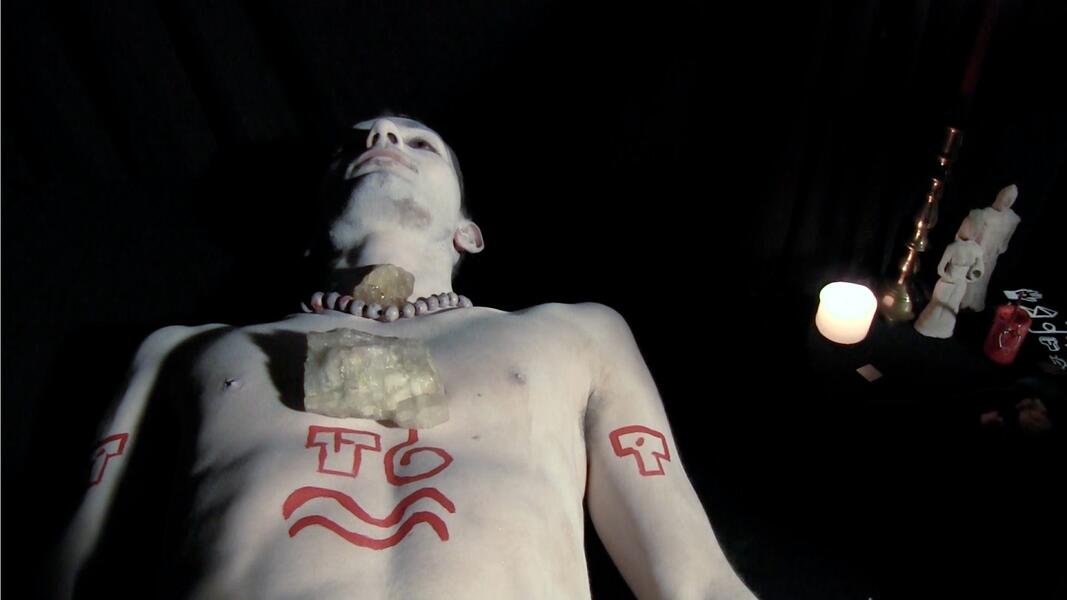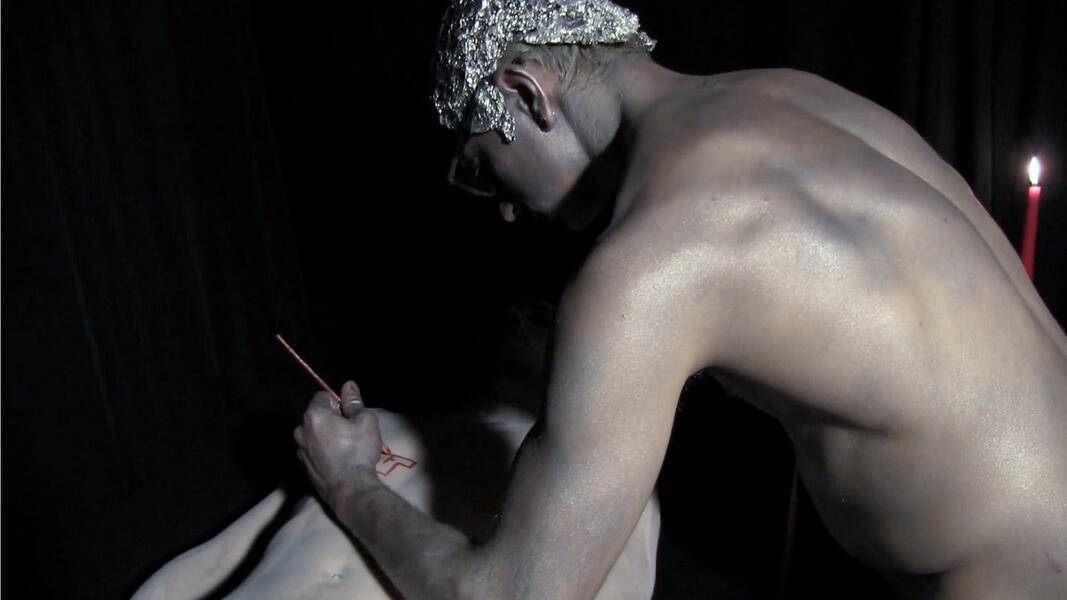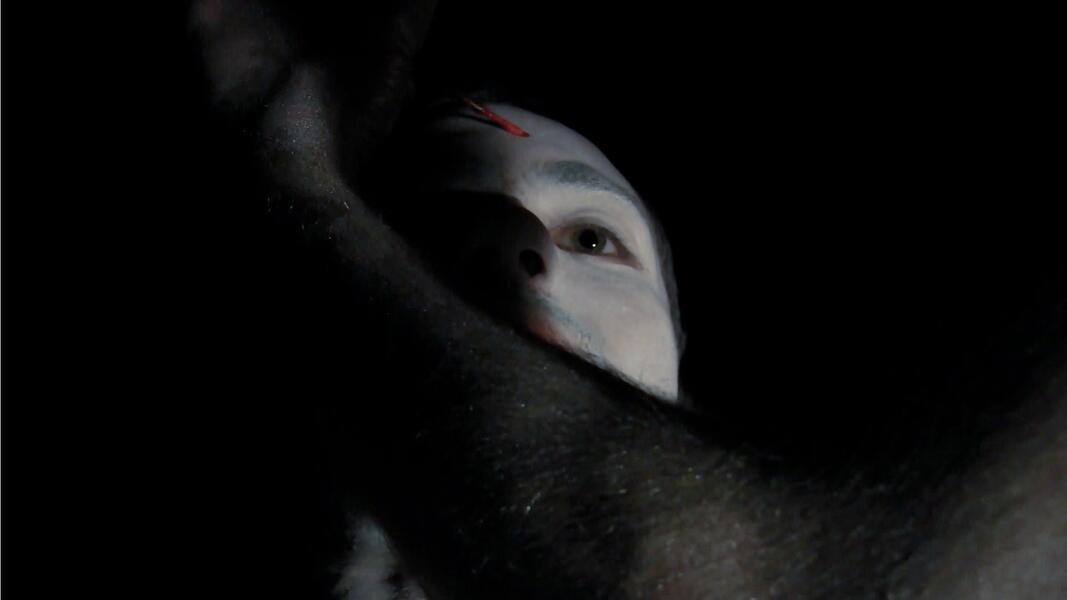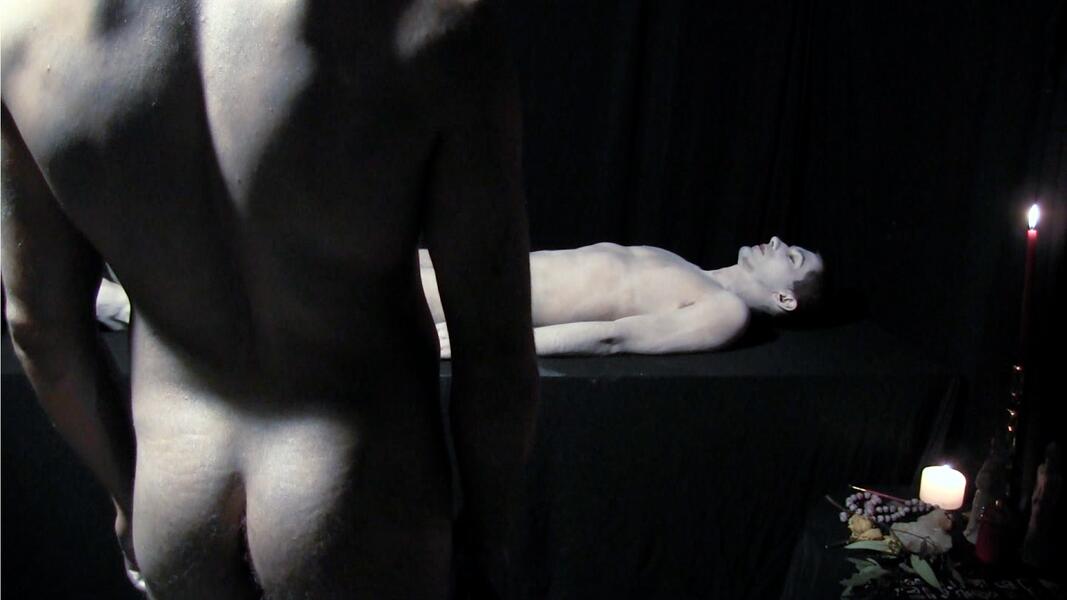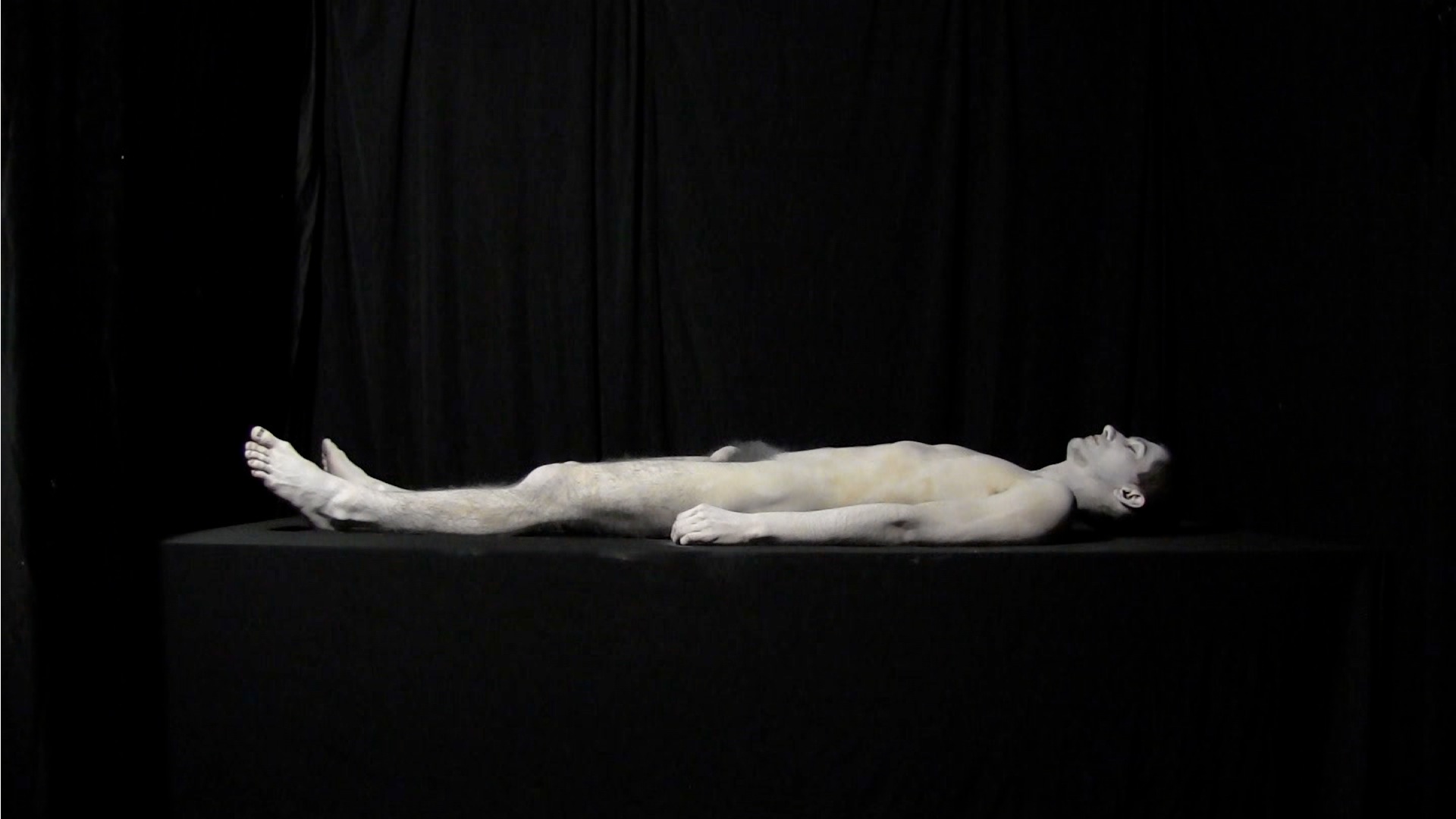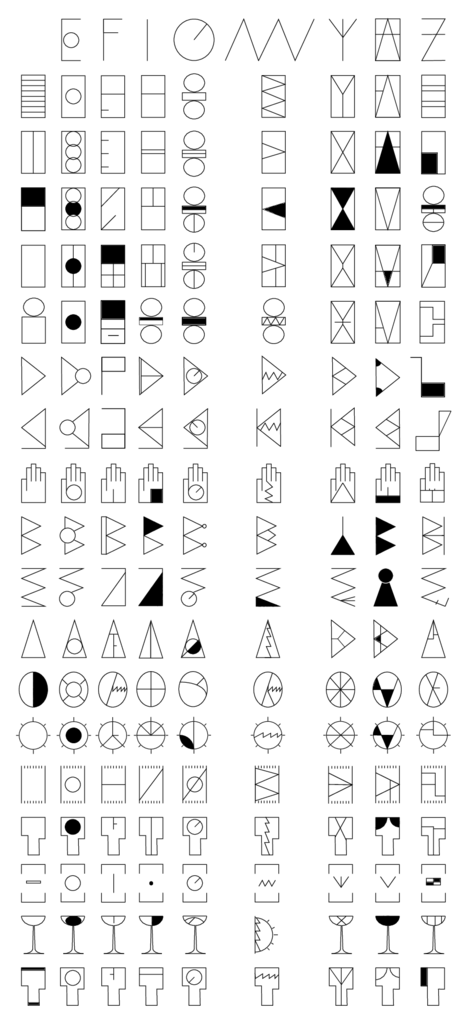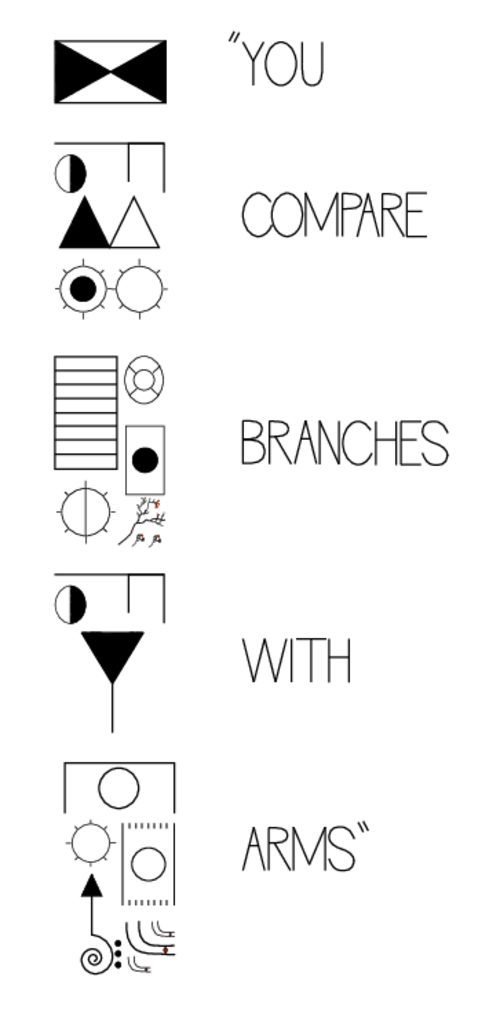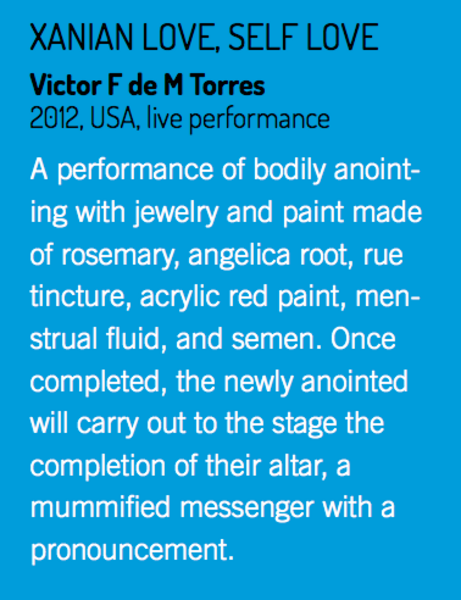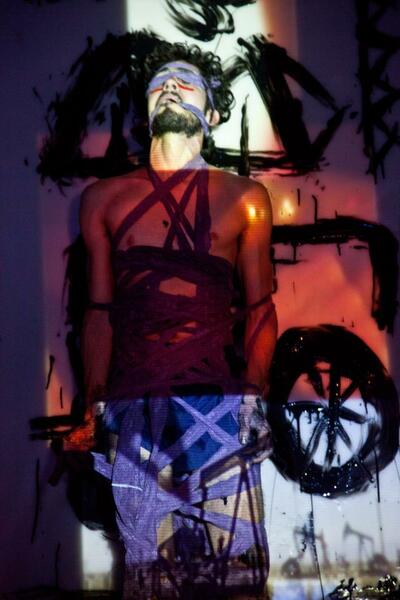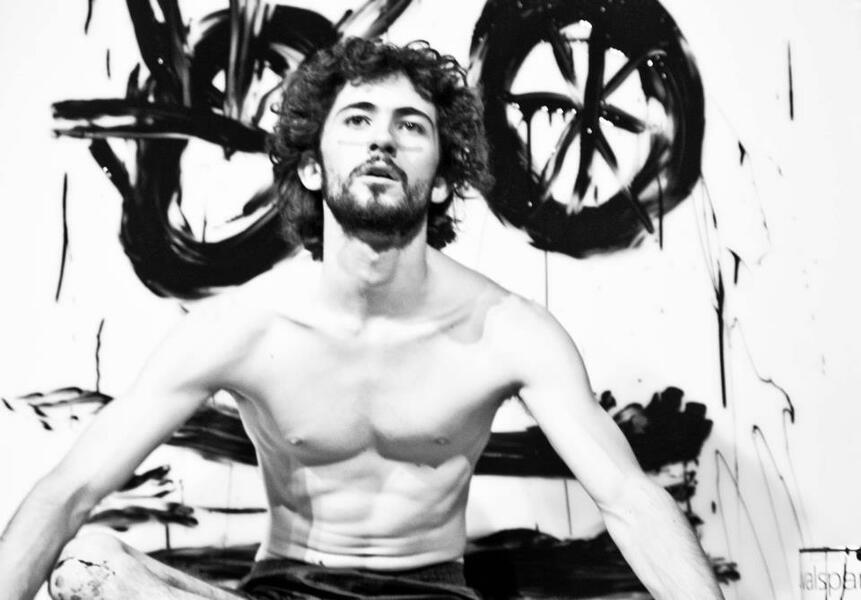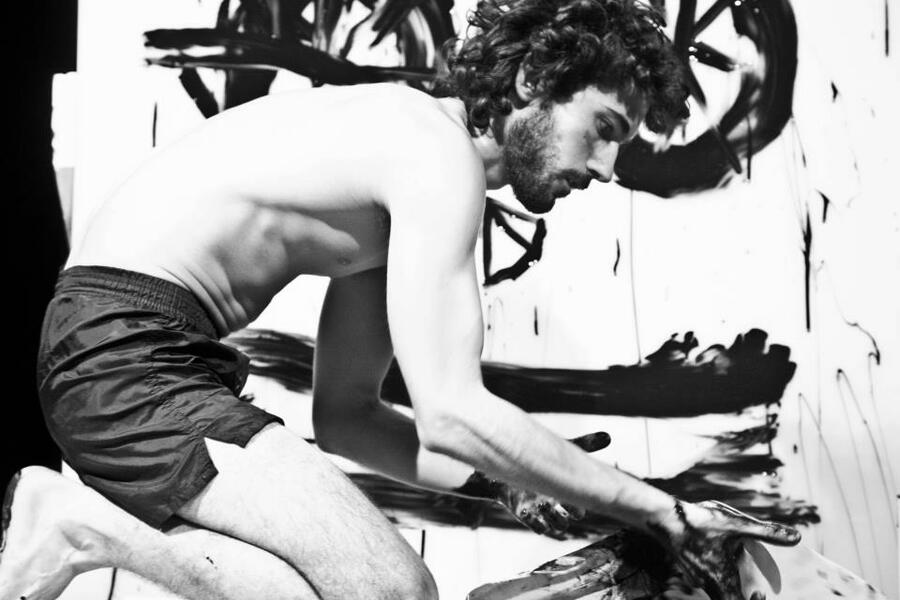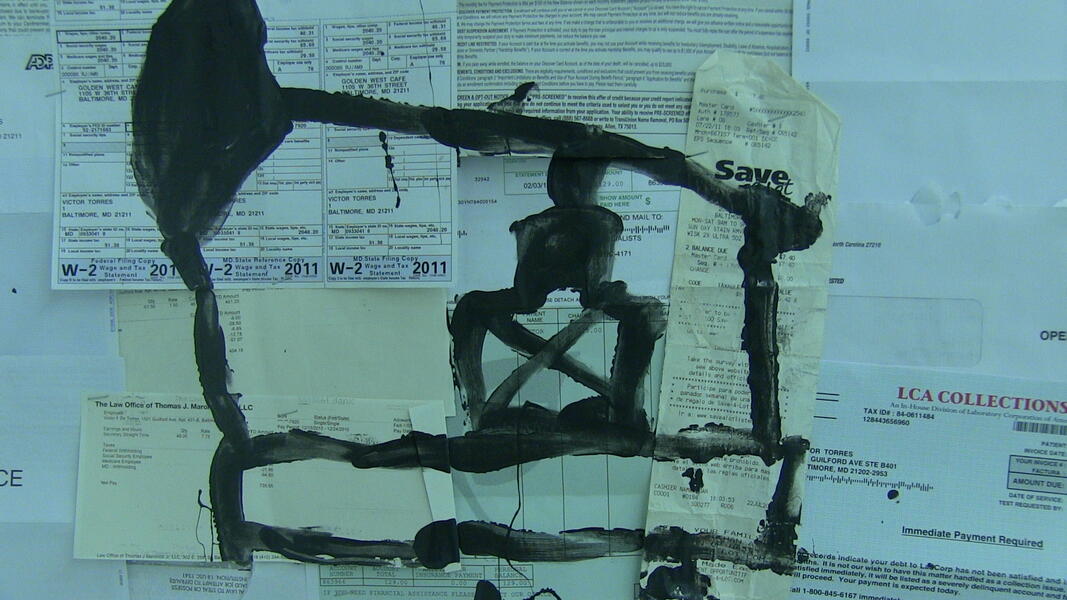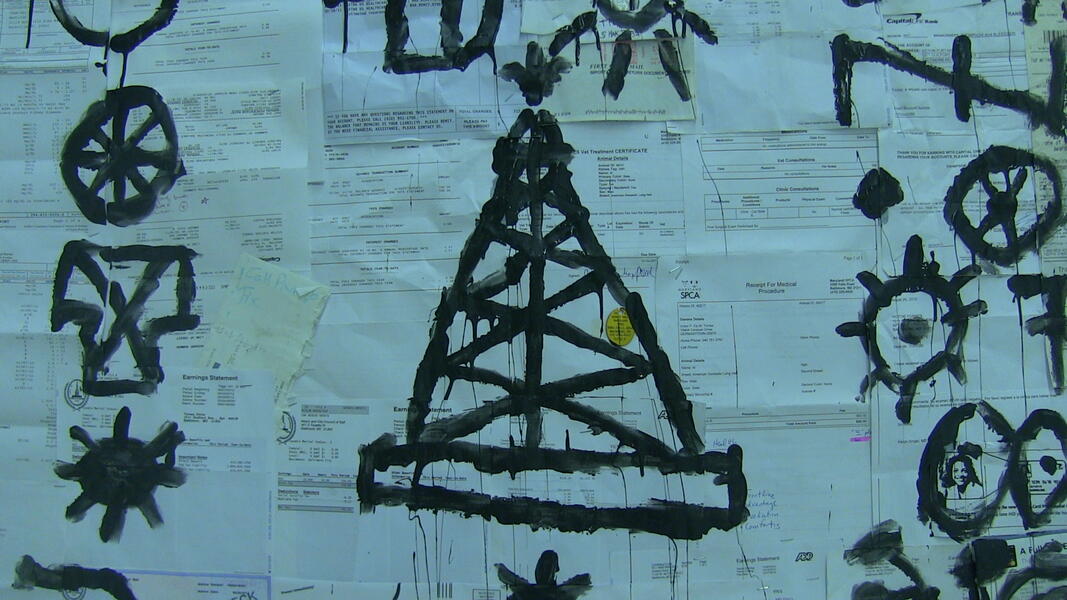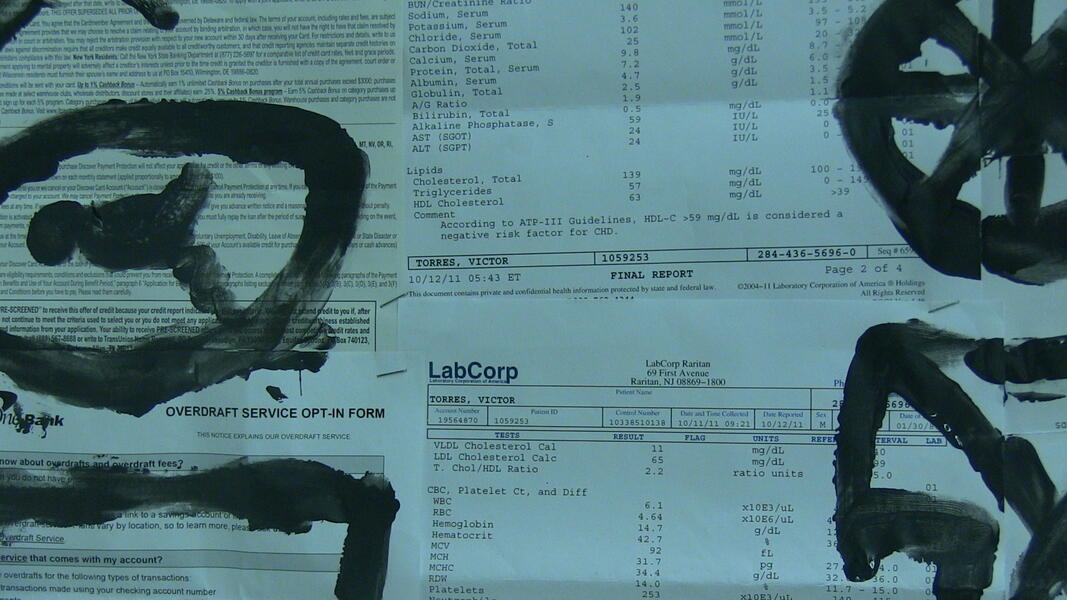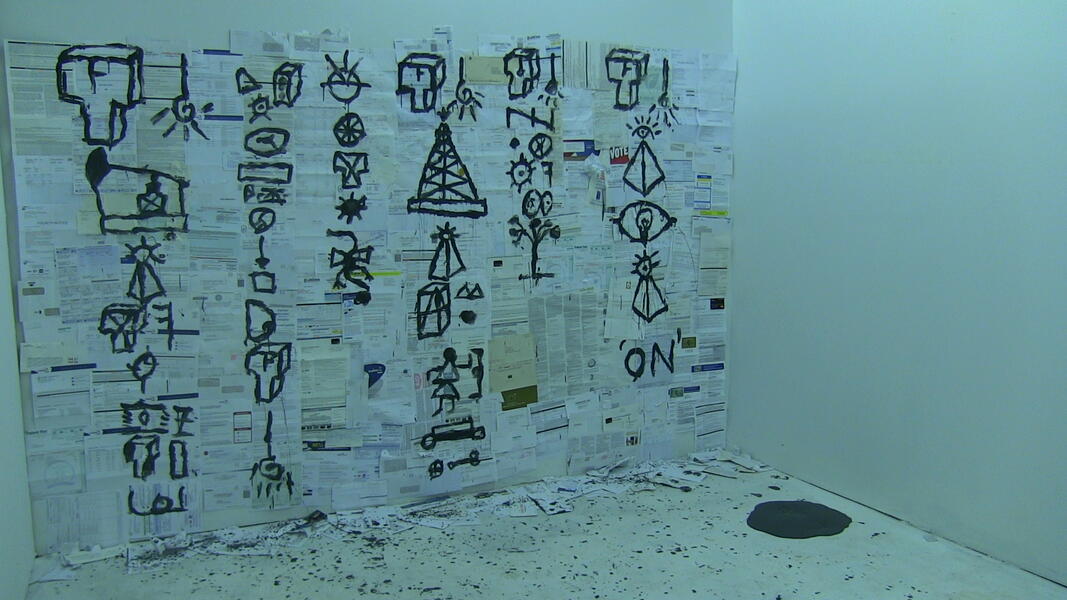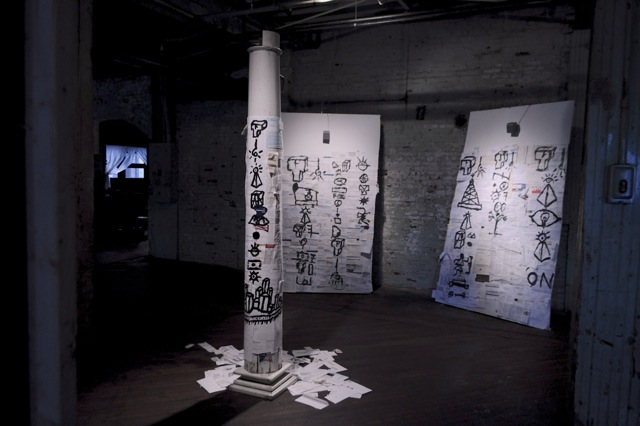About Victor
Baltimore City
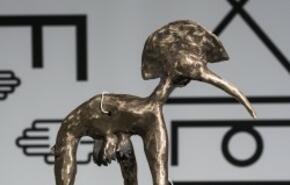
victortorres.art
Victor F M Torres is an interdisciplinary and intermedia artist born in Rio de Janeiro, Brazil. He currently lives between Baltimore, Maryland, and New York, NY. Torres is a visiting assistant professor at Stevenson University. Torres holds an MFA in Intermedia and Digital Arts from the University of Maryland, Baltimore County (UMBC) as well as a B.A. in Socio-Cultural Anthropology, from the… more
Victor F M Torres is an interdisciplinary and intermedia artist born in Rio de Janeiro, Brazil. He currently lives between Baltimore, Maryland, and New York, NY. Torres is a visiting assistant professor at Stevenson University. Torres holds an MFA in Intermedia and Digital Arts from the University of Maryland, Baltimore County (UMBC) as well as a B.A. in Socio-Cultural Anthropology, from the… more
Jump to a project:
Language Writes Myth Writes Reality: Or, How Does the Acculturated Body Take the Role of Culture-Maker?
Myths are taught and taken as values through enculturation, which serves to socialize the individual. When a specific set of myths or “common-senses” and “ways of seeing” are taught to and expected from a large group of individuals, the outcome, to my mind, is a form of colonization that is often disguised as acculturation or socialization. Myths are devised by generations upon generations of stories, which form cultural constructs divulged mainly through language, or a collection of millennial sounds acting in conjunction with their visual representations and functioning as capsules of meaning.
I believe that examining the historical trajectory of sounds, their meanings and notation systems – i.e. writing systems - is pivotal not only to understanding and tracking how human perception has changed over millennia, but also to how we can re-write societal norms—how we can re-colonize, if you will, the phenomenon of colonization. Throughout my work, I explore the experience of an acculturated body (also known as the diasporic individual, or immigrant) taking on the role of the protagonist, turning colonization on its head; something Hollywood could never grant Carmen Miranda – one of the only lasting representations of Brazil outside of Latin America – despite her arduous attempts.
In my research, I choose the phrase re-colonize and thematically, I take an anthropological perspective to call attention to and open up space for the creation, as well as the active dissemination of new myths which allow the immigrant, the marginalized, the non-normative to become the protagonist.
Contemplating the historical trajectory of sounds and the evolution of their notation systems serves as a tool for re-programming language. The result is a language I have constructed that resembles the grammatical and morphological makeup of ancient languages. I explore these languages through intermedia installations, touch-sensitive conductive sculptures, and durational performances that have constituted the main forms of dissemination of my research.
I believe that examining the historical trajectory of sounds, their meanings and notation systems – i.e. writing systems - is pivotal not only to understanding and tracking how human perception has changed over millennia, but also to how we can re-write societal norms—how we can re-colonize, if you will, the phenomenon of colonization. Throughout my work, I explore the experience of an acculturated body (also known as the diasporic individual, or immigrant) taking on the role of the protagonist, turning colonization on its head; something Hollywood could never grant Carmen Miranda – one of the only lasting representations of Brazil outside of Latin America – despite her arduous attempts.
In my research, I choose the phrase re-colonize and thematically, I take an anthropological perspective to call attention to and open up space for the creation, as well as the active dissemination of new myths which allow the immigrant, the marginalized, the non-normative to become the protagonist.
Contemplating the historical trajectory of sounds and the evolution of their notation systems serves as a tool for re-programming language. The result is a language I have constructed that resembles the grammatical and morphological makeup of ancient languages. I explore these languages through intermedia installations, touch-sensitive conductive sculptures, and durational performances that have constituted the main forms of dissemination of my research.
-
 Syllabary, 2013Syllabary, 2013 represents the ultimate colonization and peak refinement of once finger-painted symbols in ecstatic performance and ancient archetypal possession rituals, as well as autohypnosis. Now the language has been completely codified, unified, and homogenized in order to propagate ultimate trust, however thinly veiled it may be as one-sided colonialist control. Matt Mullican’s process and craftsmanship serve as an important point of contemporary contextualization for this piece in particular.
Syllabary, 2013Syllabary, 2013 represents the ultimate colonization and peak refinement of once finger-painted symbols in ecstatic performance and ancient archetypal possession rituals, as well as autohypnosis. Now the language has been completely codified, unified, and homogenized in order to propagate ultimate trust, however thinly veiled it may be as one-sided colonialist control. Matt Mullican’s process and craftsmanship serve as an important point of contemporary contextualization for this piece in particular. -
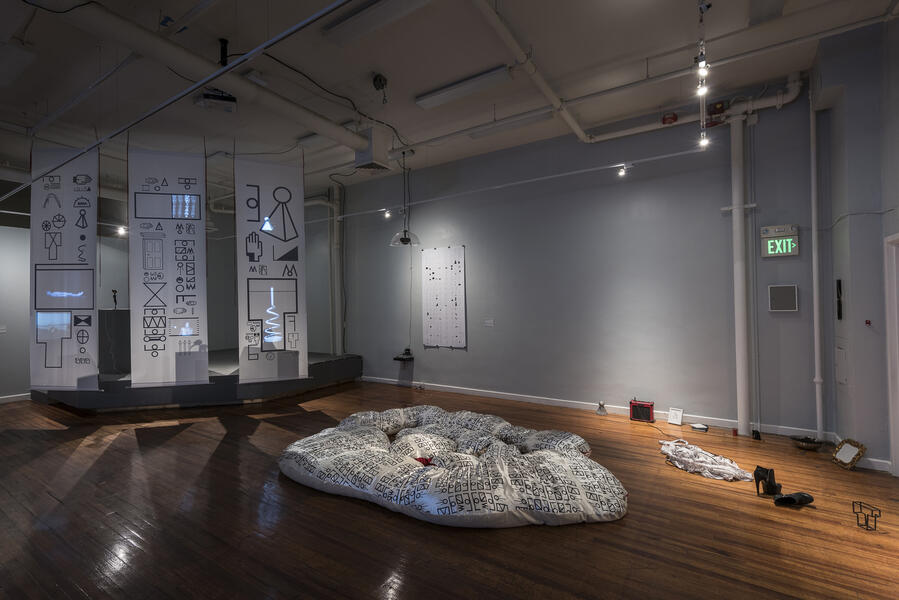 Pillows/ Vivências, 2015A group of pillows evocative of the Brazilian installation art concept of vivências, which marked a turning point in the deconstruction of audience vs art dichotomy. Participants were invited to sit and make themselves comfortable in what is often considered a stiff gallery environment.
Pillows/ Vivências, 2015A group of pillows evocative of the Brazilian installation art concept of vivências, which marked a turning point in the deconstruction of audience vs art dichotomy. Participants were invited to sit and make themselves comfortable in what is often considered a stiff gallery environment. -
 Enculturation Machine: Or, the Way Mummy Talks, 2015Enculturation Machine: Or, the Way Mummy Talks 2015 Durational Performance. Description of Performance: The artist circled the space about three times. He then sat down on the floor with his back to the audience and started to pull his own hair and cut it with a pair of scissors while occasionally looking at the mirror in front of him. The artist followed this action by picking up a marine blue book and started to read a creation myth in an unknown language, original to the work. He translated the poem every couple of lines. After the artist finished reading and translating the poem he started to mummify himself with originally print bundle of cotton fabric. As it became impossible to complete the mummification by himself, the artist asked for assistance from an audience member who eagerly finished the mummification. The artist lay on the floor of the gallery mummified for approximately 2 hours. MAP (Maryland Art Place) Baltimore, MD. Photo Credit: Dan Meyers
Enculturation Machine: Or, the Way Mummy Talks, 2015Enculturation Machine: Or, the Way Mummy Talks 2015 Durational Performance. Description of Performance: The artist circled the space about three times. He then sat down on the floor with his back to the audience and started to pull his own hair and cut it with a pair of scissors while occasionally looking at the mirror in front of him. The artist followed this action by picking up a marine blue book and started to read a creation myth in an unknown language, original to the work. He translated the poem every couple of lines. After the artist finished reading and translating the poem he started to mummify himself with originally print bundle of cotton fabric. As it became impossible to complete the mummification by himself, the artist asked for assistance from an audience member who eagerly finished the mummification. The artist lay on the floor of the gallery mummified for approximately 2 hours. MAP (Maryland Art Place) Baltimore, MD. Photo Credit: Dan Meyers -
 Al, 2015Al, 2015 Solid Cast Bronze Originally displayed as part of Acculturation Machine, 2015, Al is a conductive solid Bronze sculpture. Al was made using lost-wax method and cannot be reproduced. This piece explores the fluidity of gender and as “beast” is depicts what society at- tempts to tame. As an “idol” it serves as an active attempt to be an myth-maker both as an artist and immigrant. MAP (Maryland Art Place) Baltimore, MD. Photo Credit: Dan Meyers
Al, 2015Al, 2015 Solid Cast Bronze Originally displayed as part of Acculturation Machine, 2015, Al is a conductive solid Bronze sculpture. Al was made using lost-wax method and cannot be reproduced. This piece explores the fluidity of gender and as “beast” is depicts what society at- tempts to tame. As an “idol” it serves as an active attempt to be an myth-maker both as an artist and immigrant. MAP (Maryland Art Place) Baltimore, MD. Photo Credit: Dan Meyers -
 On, 2014On, 2015 Cast Bronze Originally displayed as part of Acculturation Machine, 2015, Al is a conductive Bronze sculpture. On was made using lost-wax method and cannot be reproduced. This piece acts as a physical representation of the immense forms that language can take, in this case a 3 dimensional word, “On.” As an “idol” it serves as an active attempt to be an myth-maker both as an artist and immigrant. MAP (Maryland Art Place) Baltimore, MD. Photo Credit: Dan Meyers
On, 2014On, 2015 Cast Bronze Originally displayed as part of Acculturation Machine, 2015, Al is a conductive Bronze sculpture. On was made using lost-wax method and cannot be reproduced. This piece acts as a physical representation of the immense forms that language can take, in this case a 3 dimensional word, “On.” As an “idol” it serves as an active attempt to be an myth-maker both as an artist and immigrant. MAP (Maryland Art Place) Baltimore, MD. Photo Credit: Dan Meyers -
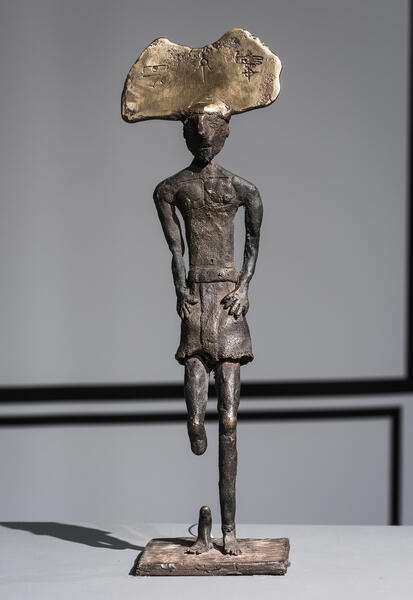 X(On), 2014(X)On, 2015 Solid Cast Bronze Originally displayed as part of Acculturation Machine, 2015, (X)On is a conductive solid Bronze sculpture. (X)On was made using lost-wax method and cannot be reproduced. This piece is emblematic of my linguistic and anthropological research regarding Proto-Indo-European (PIE) together with an active attempt to be an myth-maker both as an artist and immigrant. MAP (Maryland Art Place) Baltimore, MD.
X(On), 2014(X)On, 2015 Solid Cast Bronze Originally displayed as part of Acculturation Machine, 2015, (X)On is a conductive solid Bronze sculpture. (X)On was made using lost-wax method and cannot be reproduced. This piece is emblematic of my linguistic and anthropological research regarding Proto-Indo-European (PIE) together with an active attempt to be an myth-maker both as an artist and immigrant. MAP (Maryland Art Place) Baltimore, MD. -
 Acculturation Machine, 2015Acculturation Machine, 2015 Multimedia Interactive Installation Broad shot of intermedia interactive installation where participants were invited to touch bronze cast sculptures hard wired to a computer in order to trigger projections and sound upon touch. The projections consisted of images that augmented the participants understanding of foreign-ness. These images were projected on 12foot tall frosted mylar scrolls with printed hieroglyphs of an original conceptual yet highly grammatical constructed language central to my process. MAP (Maryland Art Place) Baltimore, MD.
Acculturation Machine, 2015Acculturation Machine, 2015 Multimedia Interactive Installation Broad shot of intermedia interactive installation where participants were invited to touch bronze cast sculptures hard wired to a computer in order to trigger projections and sound upon touch. The projections consisted of images that augmented the participants understanding of foreign-ness. These images were projected on 12foot tall frosted mylar scrolls with printed hieroglyphs of an original conceptual yet highly grammatical constructed language central to my process. MAP (Maryland Art Place) Baltimore, MD.
Labbodies Performances 2014
Various durational performance pieces at Labbodies events throughout the year.
Respective brief descriptions under photos.
Respective brief descriptions under photos.
-
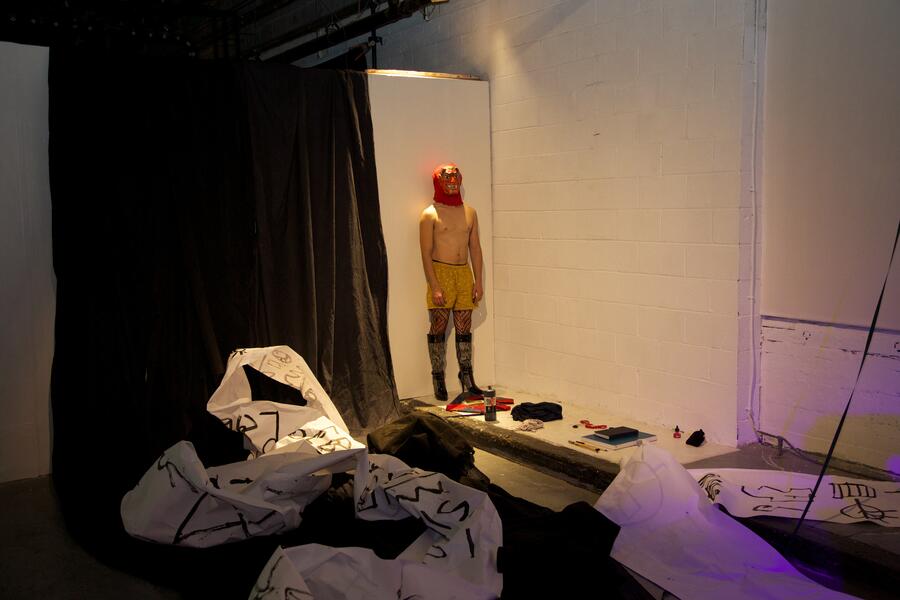 Transmodern 2014 Day2The body being displayed as an object among other objects. 4 hr long durational performance
Transmodern 2014 Day2The body being displayed as an object among other objects. 4 hr long durational performance -
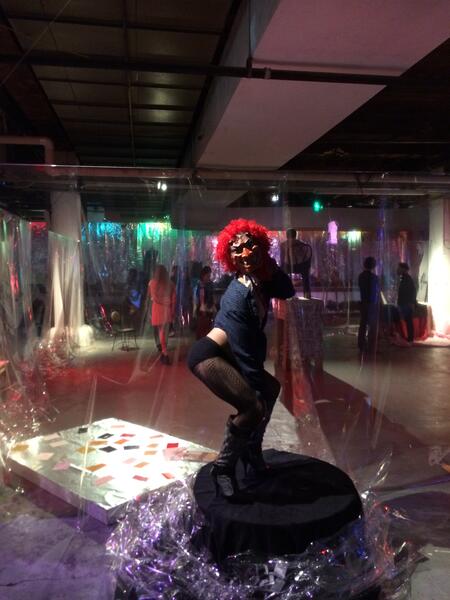 Transmodern Festival 2014 Day1Wearing the devil mask as form of personal protection. Trickster as marginalized and usurped member of society. 3 hr long durational performance
Transmodern Festival 2014 Day1Wearing the devil mask as form of personal protection. Trickster as marginalized and usurped member of society. 3 hr long durational performance -
 labbodies_bma100party_performer-biographies-21.jpg
labbodies_bma100party_performer-biographies-21.jpg -
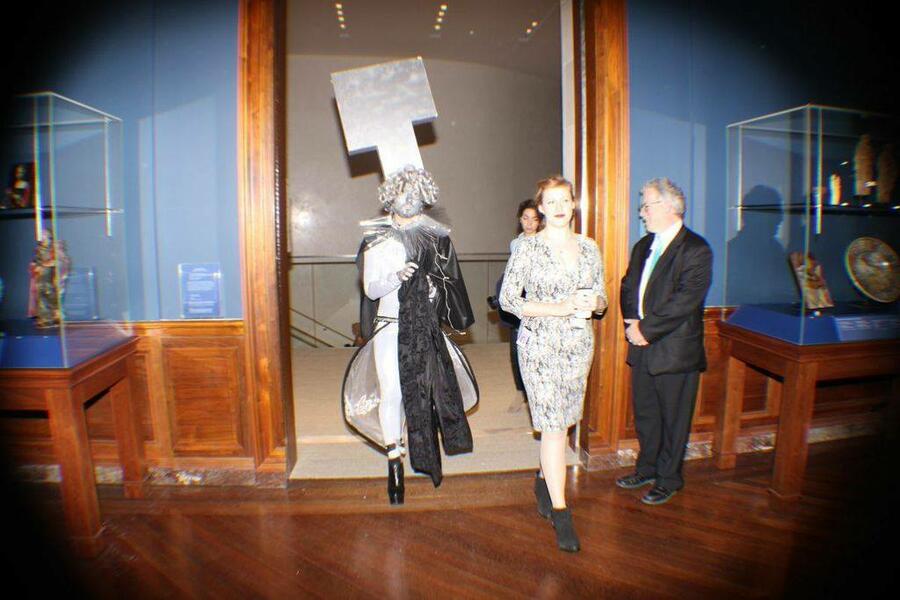 1507400_732507413498437_527574037184488589_o.jpg
1507400_732507413498437_527574037184488589_o.jpg -
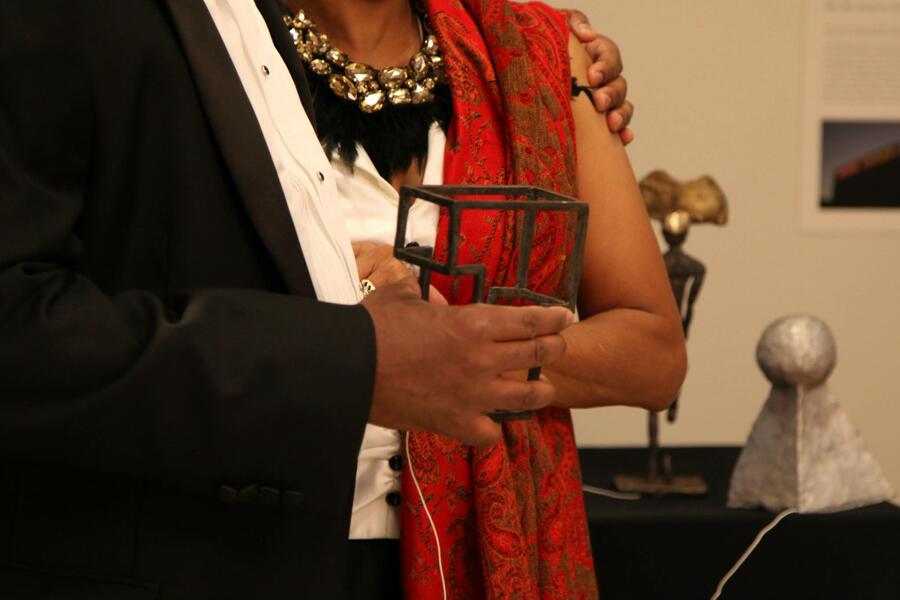 10855127_787358824684646_4132461317321269727_o.jpg
10855127_787358824684646_4132461317321269727_o.jpg -
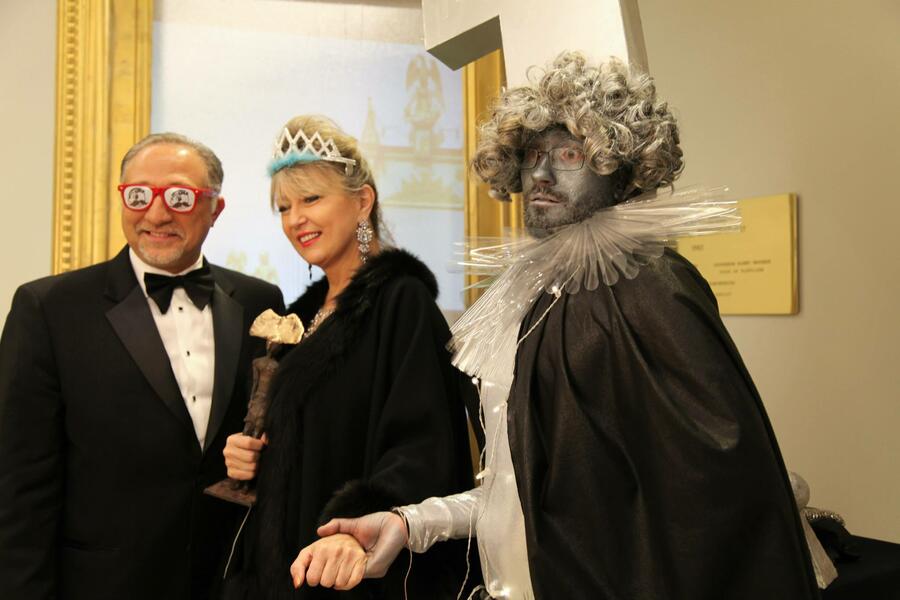 10847299_787361451351050_5985293246883771734_o.jpg
10847299_787361451351050_5985293246883771734_o.jpg -
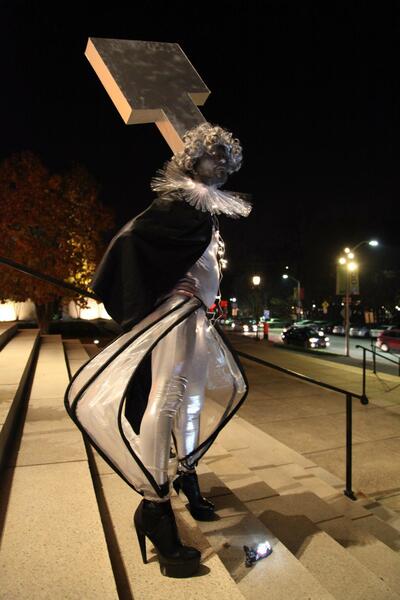 10835262_787359931351202_2159491703726674652_o.jpg
10835262_787359931351202_2159491703726674652_o.jpg -
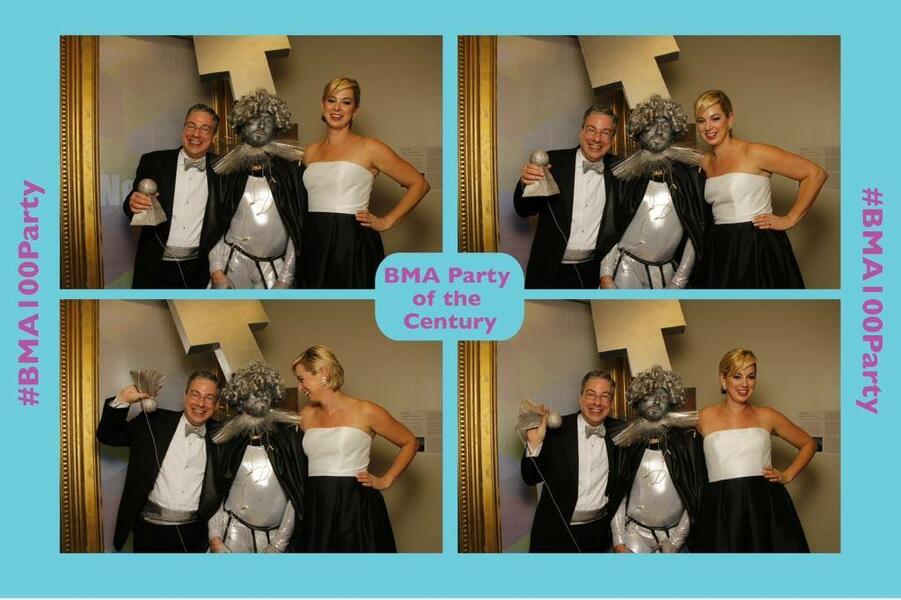 Photo Booth at BMA 100th anniversary GalaGuests were invited to perform with me at the Photo Booth while their photos were being taken. Guests were also compelled during the performances to interact with cast metal sculptures that would trigger videos and images of the newly opened American Wing at the BMA. 4.5 hr long durational performance.
Photo Booth at BMA 100th anniversary GalaGuests were invited to perform with me at the Photo Booth while their photos were being taken. Guests were also compelled during the performances to interact with cast metal sculptures that would trigger videos and images of the newly opened American Wing at the BMA. 4.5 hr long durational performance. -
 img_4653.jpg
img_4653.jpg -
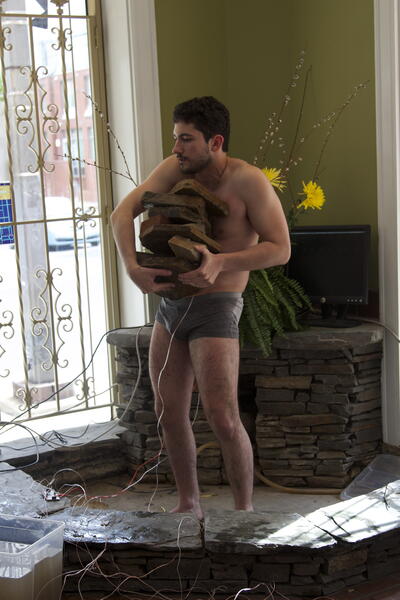 Washing StonesWater is surely the most abundant solvent. It dismantles the hardest rock and turns it to mere soot. In this 3 hour durational performance I trigger videos from 12 different inputs by washing stones and burying myself under them. The videos show found footage snippets of plant and natural history documentaries.
Washing StonesWater is surely the most abundant solvent. It dismantles the hardest rock and turns it to mere soot. In this 3 hour durational performance I trigger videos from 12 different inputs by washing stones and burying myself under them. The videos show found footage snippets of plant and natural history documentaries.
F.E.A.S.T. (performance and costumes)
As a part of the Transmodern Performance Festival of 2012 artists curated by Rebecca Nagle created an all immersive dinner theater experience involving miniature foods, occult ritual, and drinking wine out of ducktape alien computer utters.
I was responsible for he waiter staff costume design and fabrication. For the cocktail portion of the dinner I performed "Breasted Cocktail/ The Last Computer" were I embodied the last computer of a distant and dying civilization overtaken by psycho-cultural imperialism. I made direct references to the neglectful relationship between American mainstream media and the Lusophone world.
Photographs from What Weekly Magazine
Courtesy of Philip Laubner
I was responsible for he waiter staff costume design and fabrication. For the cocktail portion of the dinner I performed "Breasted Cocktail/ The Last Computer" were I embodied the last computer of a distant and dying civilization overtaken by psycho-cultural imperialism. I made direct references to the neglectful relationship between American mainstream media and the Lusophone world.
Photographs from What Weekly Magazine
Courtesy of Philip Laubner
-
The Last Computer
-
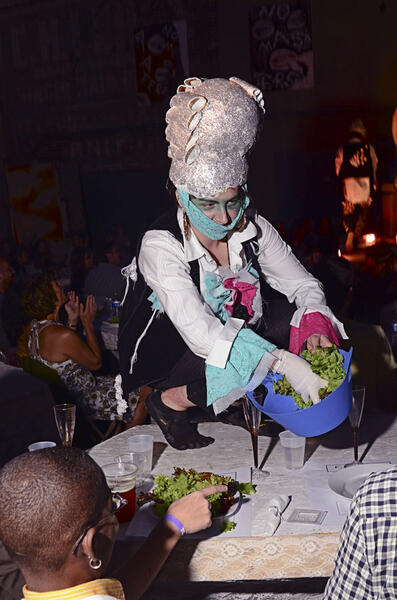 transmodern_2012_feast_laubner_9426.jpeg
transmodern_2012_feast_laubner_9426.jpeg -
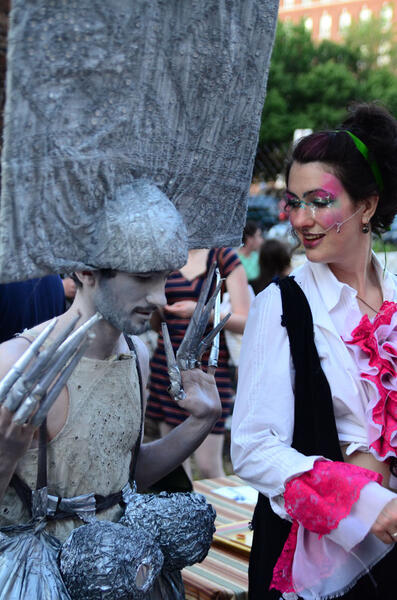 transmodern_2012_feast_laubner_9182.jpeg
transmodern_2012_feast_laubner_9182.jpeg -
 img_0529-2.jpg
img_0529-2.jpg -
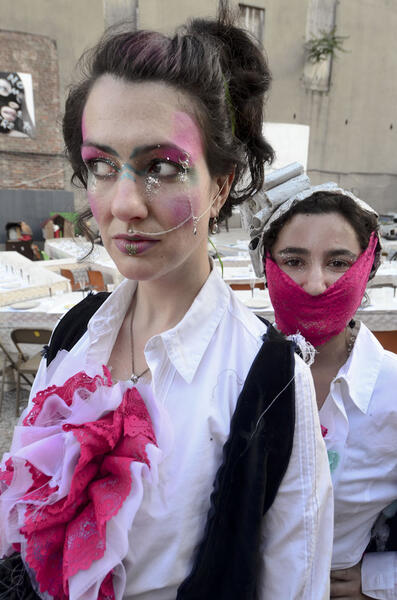 img_0528-2.jpg
img_0528-2.jpg -
The Last ComputerAudio used during performance in combination with gutural singing captured by a contact microphone duct-taped to my throat.
-
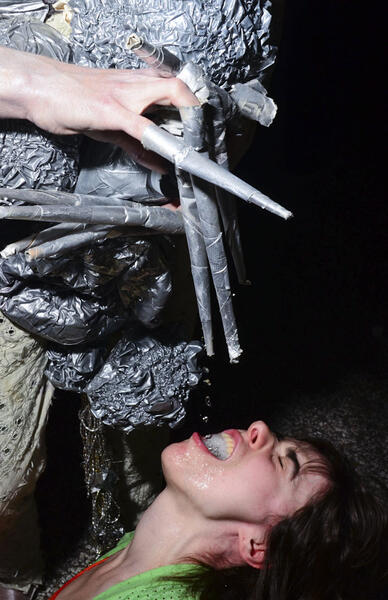 transmodern_2012_feast_laubner_9782.jpeg
transmodern_2012_feast_laubner_9782.jpeg -
 transmodern_2012_feast_laubner_9349.jpeg
transmodern_2012_feast_laubner_9349.jpeg -
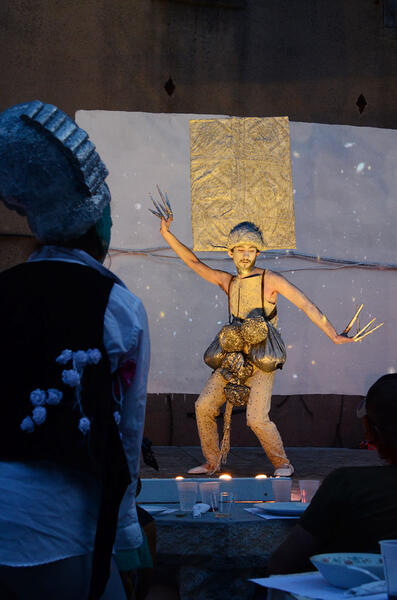 img_0463.jpg
img_0463.jpg -
 Breasted Cocktail/ The Last ComputerPhoto by Emma Alves
Breasted Cocktail/ The Last ComputerPhoto by Emma Alves
Magick Action McKeldin Square
Occupy Baltimore.
Tactical Magick performance ritual.
Participants Painted abstract representations of their intentions with regards to the Occupy movement. Participants were also encouraged to make and/or bring objects to be left at the fountain to symbolize their hopes for the future of the moment.
Tactical Magick performance ritual.
Participants Painted abstract representations of their intentions with regards to the Occupy movement. Participants were also encouraged to make and/or bring objects to be left at the fountain to symbolize their hopes for the future of the moment.
-
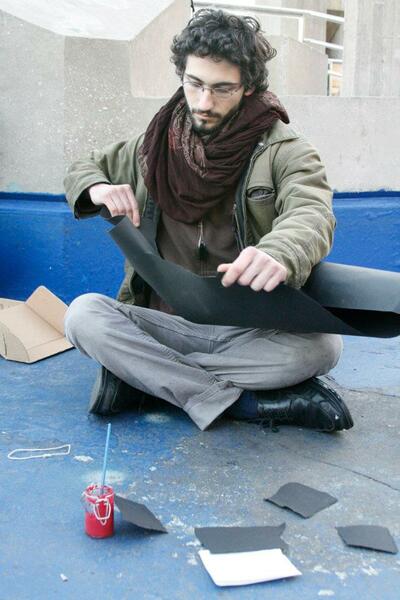 391302_284276084938256_1528474812_n.jpg
391302_284276084938256_1528474812_n.jpg -
 383025_284276121604919_1583342084_n.jpg
383025_284276121604919_1583342084_n.jpg -
 380054_284276598271538_1236970727_n.jpg
380054_284276598271538_1236970727_n.jpg -
 374940_284276661604865_126806961_n.jpg
374940_284276661604865_126806961_n.jpg -
 304126_284275894938275_1254973463_n.jpg
304126_284275894938275_1254973463_n.jpg -
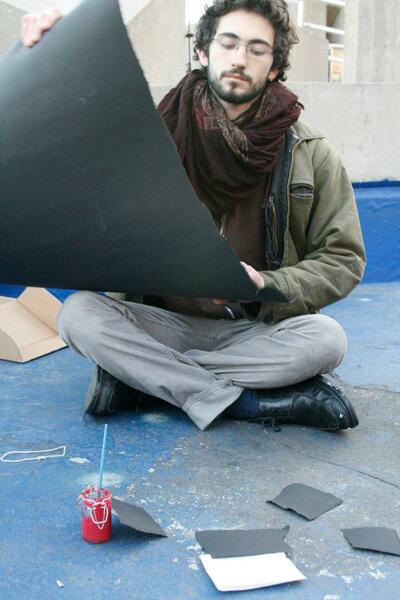 378648_284276051604926_601183396_n.jpg
378648_284276051604926_601183396_n.jpg -
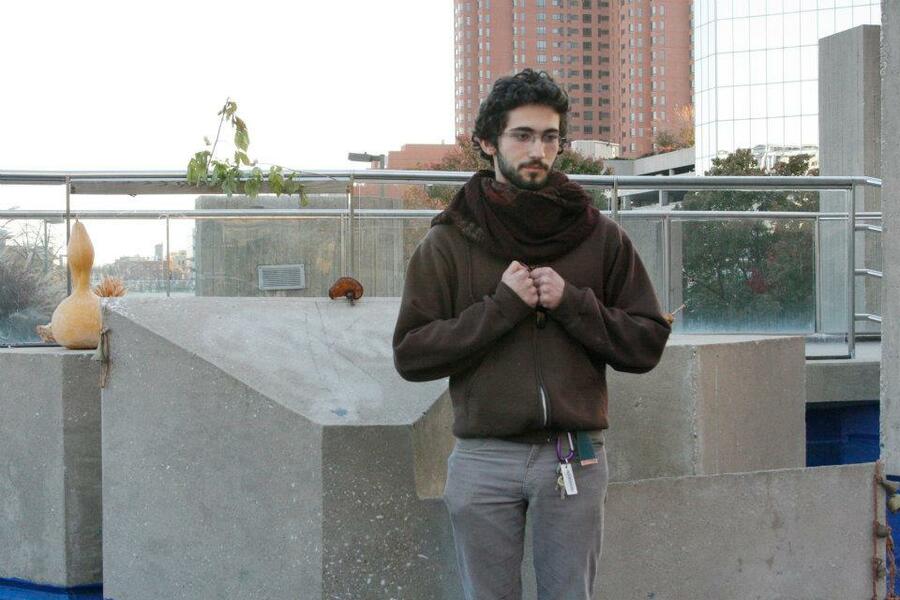 300657_284275924938272_1837500089_n.jpg
300657_284275924938272_1837500089_n.jpg -
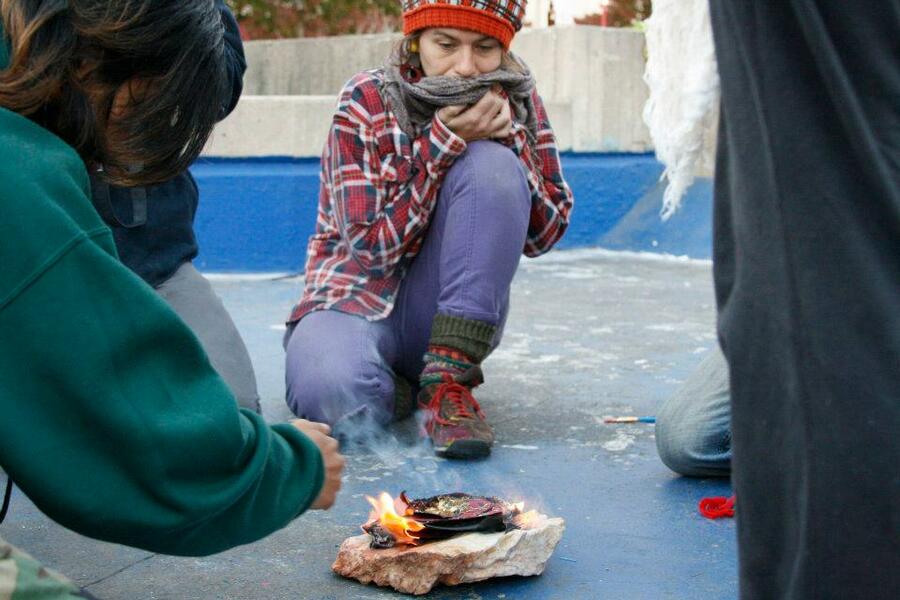 377762_284276208271577_1659000758_n.jpg
377762_284276208271577_1659000758_n.jpg
Xonian Love, Self Love, Mummification
Performance for video
Mummification has been found to be a recurring element of cultures in every continent from Africa to South America. In this work I explore the ritual of mummification as an act of self preservation. While usually associated with the preservation of the body after death, mummification is represented here as a way to preserve life and as catalyst for the rebirth of the self.
Mummification has been found to be a recurring element of cultures in every continent from Africa to South America. In this work I explore the ritual of mummification as an act of self preservation. While usually associated with the preservation of the body after death, mummification is represented here as a way to preserve life and as catalyst for the rebirth of the self.
Socialization is to the Individual as Colonization is to the Group (Six Pieces)
“Nothing served to ‘assemble’ the different peoples and vernaculars more than capitalism, which, within the limits imposed by grammars and syntaxes, created mechanically reproduced print-languages, capable of dissemination through the market.”
— “Imagined Communities” by Benedict Anderson, 1983
I believe that contemporary art is too often informed by complacent cultural consumption. My aim as an artist is to question and even reverse my consumption of prefabricated cultural mechanisms. Instead, as a person socialized to relate to and communicate with other persons (as all persons are), my aim is to engage in actively and consciously consuming cultural systems of communication in order to bore into and unpack them, thereby gaining a deeper understanding of how meaning is made.
The process known as socialization has an efficient way of perpetuating itself by making cultural attributes and associations subliminal or subconscious. Cultural norms, which constitute the very bedrock of society, are the strongest when consumed and reproduced subliminally. For that reason, I need to know where every phoneme that I use comes from. For example, the sounds that make up the word elegant, where do they come from? What other words use these sounds?
Socialization works on one individual just as colonization works on a group of individuals. My work, then, is an attempt to re-socialize, re-colonize, and re-appropriate myself and in so doing, to create a potential model for a new (or at least different) culture.
My efforts are illustrated through the pieces that follow:
*leikw – Inheritance, Elegant, Election (phonetic connotations series), 2013
*leikw — is a video triptych of my mouth reproducing phonemes while exploring the many paths of alliteration by which meaning comes into being. These videos are simulations of the trajectory that phonetics have taken over time through the de/re-contextualizations resulting from human migration. For example, in “Elegant,” I start incessantly repeating the PIE (Proto-Indo-European) word *leikw —. The repetitions quickly morph into eleg- which transforms into the Latin eligere, subsequently transmuting into elegans – elegantis and finally the modern English word “elegant.” *leikw – is the Proto-Indo-European word for “inheritance,” which is phonologically closely related to the Latin root eleg-, meaning choice.
In this case, “phonologically related” means that the most distinctive sounds are the liquid alveolar sound l followed by a velar stop kw or g. The piece explores the notion in comparative linguistics that sounds using the same oral muscles or cavities are often interchangeable. These modifications happen due to cultural influences, migrations, linguistic assimilations (i.e., oral translations), and finally genetic mutation. *leikw – is an attempt to illustrate clearly the process used to identify key sound forms in modern languages in order to show how units of sounds that serve as building blocks to the words we use today have pre-determined meanings constructed through a long history. The central purpose of this exercise was the development of a new representation model for language and concepts.
Now, you may wonder, what is the connection between “inheritance” and the adjective “elegant”? To answer that question, we must try to transpose ourselves into the environment in which the Proto-Indo-European sounds originated. The experience is purely conceptual by nature, but it does yield a rather clarifying observation: Inheritance comes with privilege, which in turn produces the luxury of choice. In an abundance of choice there's a game or protocol that is cultural by conception. The ability to understand this game and work it, making the “right” choices, becomes a marker of elegance.
Three and Three Poems, 2013, prints
This piece is a triptych of prints of the same poem each in a different mode of representation. Each concept has been meticulously translated. It introduces Om (?), the Vedic concept for the sacred and eternal hum of the universe, as a verb. In highly reductive terms, the verb to om could be equated to a metaphysical aspect of the English verb ‘to be.’ The title is an homage and reference to Joseph Kosuth’s One and Three Chairs, 1965.
Syllabic System of Sounds Table 1, 2013, print
Syllabic System of Sounds Table 1 is central to the development of a new model of representation for language and concepts. The symbols listed are elements that when put together make concepts much like words and letters.
The first column on the left comprises a list of representations of single consonantal phonetic sound units. The top row is a list of single vowel phonemes, which are the unrestricted flow sounds (ah, eh, ih, aw, oh, ooh, and the diphthongs au and ae). Consonants provide a mold for unrestricted vocal cord movements, creating other phonological units such as syllables. All other signs on the chart are combinations of restrictions followed by unrested sounds, creating perfect syllables or a consonant followed by a vowel. For example the second row reads: B’, BA, BEH, BI, BAW, BO, BOOH, BAU, BAE.
Syllabic System of Sounds Table 1 represents the ultimate colonization and peak refinement of once finger-painted symbols in ecstatic performance based on ancient archetypal possession rituals and autohypnosis. Now the language has been completely codified, unified, and homogenized in order to propagate ultimate trust, however thinly veiled it may be as one-sided colonialist control. Matt Mullican’s process and craftsmanship serve as an important point of contemporary contextualization for this piece in particular.
“You Compare Branches with Arms”, 2013, print
Informed by Wittgenstein’s “Lectures on Aesthetics,” this exercise explores the relationship between morphology, syntax, and translation.
Anderson, Benedict R. O. Imagined Communities:Rreflections on the Origin and Spread of Nationalism. (London: Verso, 1983).
Kosuth, Joseph. Art After Philosophy and After: Collected Writings, 1966-1990. (Cambridge, Mass.: MIT Press, 1991).
Mallory, J. P., and Douglas Q. Adams. The Oxford Introduction to Proto Indo European and the Proto Indo European World. (New York: Oxford University Press, 2006).
Mullican, Matt. Subject Element Sign Frame World. (New York: Skira Rizzoli Punblications, 2013).
Weingart, Wolfgang, and Katharine Wolff. Typography: My Way to Typography; Retrospective in Ten Sections. (Baden/Switzerland: Müller, 2000).
Wittgenstein, Ludwig. “Lectures on Aesthetics”. in Philosophy of Art and Aesthetics: From Plato to Wittgenstein, ed. Frank A. Tillman et all. (New York: Haddon Craftsmen, 1969).
— “Imagined Communities” by Benedict Anderson, 1983
I believe that contemporary art is too often informed by complacent cultural consumption. My aim as an artist is to question and even reverse my consumption of prefabricated cultural mechanisms. Instead, as a person socialized to relate to and communicate with other persons (as all persons are), my aim is to engage in actively and consciously consuming cultural systems of communication in order to bore into and unpack them, thereby gaining a deeper understanding of how meaning is made.
The process known as socialization has an efficient way of perpetuating itself by making cultural attributes and associations subliminal or subconscious. Cultural norms, which constitute the very bedrock of society, are the strongest when consumed and reproduced subliminally. For that reason, I need to know where every phoneme that I use comes from. For example, the sounds that make up the word elegant, where do they come from? What other words use these sounds?
Socialization works on one individual just as colonization works on a group of individuals. My work, then, is an attempt to re-socialize, re-colonize, and re-appropriate myself and in so doing, to create a potential model for a new (or at least different) culture.
My efforts are illustrated through the pieces that follow:
*leikw – Inheritance, Elegant, Election (phonetic connotations series), 2013
*leikw — is a video triptych of my mouth reproducing phonemes while exploring the many paths of alliteration by which meaning comes into being. These videos are simulations of the trajectory that phonetics have taken over time through the de/re-contextualizations resulting from human migration. For example, in “Elegant,” I start incessantly repeating the PIE (Proto-Indo-European) word *leikw —. The repetitions quickly morph into eleg- which transforms into the Latin eligere, subsequently transmuting into elegans – elegantis and finally the modern English word “elegant.” *leikw – is the Proto-Indo-European word for “inheritance,” which is phonologically closely related to the Latin root eleg-, meaning choice.
In this case, “phonologically related” means that the most distinctive sounds are the liquid alveolar sound l followed by a velar stop kw or g. The piece explores the notion in comparative linguistics that sounds using the same oral muscles or cavities are often interchangeable. These modifications happen due to cultural influences, migrations, linguistic assimilations (i.e., oral translations), and finally genetic mutation. *leikw – is an attempt to illustrate clearly the process used to identify key sound forms in modern languages in order to show how units of sounds that serve as building blocks to the words we use today have pre-determined meanings constructed through a long history. The central purpose of this exercise was the development of a new representation model for language and concepts.
Now, you may wonder, what is the connection between “inheritance” and the adjective “elegant”? To answer that question, we must try to transpose ourselves into the environment in which the Proto-Indo-European sounds originated. The experience is purely conceptual by nature, but it does yield a rather clarifying observation: Inheritance comes with privilege, which in turn produces the luxury of choice. In an abundance of choice there's a game or protocol that is cultural by conception. The ability to understand this game and work it, making the “right” choices, becomes a marker of elegance.
Three and Three Poems, 2013, prints
This piece is a triptych of prints of the same poem each in a different mode of representation. Each concept has been meticulously translated. It introduces Om (?), the Vedic concept for the sacred and eternal hum of the universe, as a verb. In highly reductive terms, the verb to om could be equated to a metaphysical aspect of the English verb ‘to be.’ The title is an homage and reference to Joseph Kosuth’s One and Three Chairs, 1965.
Syllabic System of Sounds Table 1, 2013, print
Syllabic System of Sounds Table 1 is central to the development of a new model of representation for language and concepts. The symbols listed are elements that when put together make concepts much like words and letters.
The first column on the left comprises a list of representations of single consonantal phonetic sound units. The top row is a list of single vowel phonemes, which are the unrestricted flow sounds (ah, eh, ih, aw, oh, ooh, and the diphthongs au and ae). Consonants provide a mold for unrestricted vocal cord movements, creating other phonological units such as syllables. All other signs on the chart are combinations of restrictions followed by unrested sounds, creating perfect syllables or a consonant followed by a vowel. For example the second row reads: B’, BA, BEH, BI, BAW, BO, BOOH, BAU, BAE.
Syllabic System of Sounds Table 1 represents the ultimate colonization and peak refinement of once finger-painted symbols in ecstatic performance based on ancient archetypal possession rituals and autohypnosis. Now the language has been completely codified, unified, and homogenized in order to propagate ultimate trust, however thinly veiled it may be as one-sided colonialist control. Matt Mullican’s process and craftsmanship serve as an important point of contemporary contextualization for this piece in particular.
“You Compare Branches with Arms”, 2013, print
Informed by Wittgenstein’s “Lectures on Aesthetics,” this exercise explores the relationship between morphology, syntax, and translation.
Anderson, Benedict R. O. Imagined Communities:Rreflections on the Origin and Spread of Nationalism. (London: Verso, 1983).
Kosuth, Joseph. Art After Philosophy and After: Collected Writings, 1966-1990. (Cambridge, Mass.: MIT Press, 1991).
Mallory, J. P., and Douglas Q. Adams. The Oxford Introduction to Proto Indo European and the Proto Indo European World. (New York: Oxford University Press, 2006).
Mullican, Matt. Subject Element Sign Frame World. (New York: Skira Rizzoli Punblications, 2013).
Weingart, Wolfgang, and Katharine Wolff. Typography: My Way to Typography; Retrospective in Ten Sections. (Baden/Switzerland: Müller, 2000).
Wittgenstein, Ludwig. “Lectures on Aesthetics”. in Philosophy of Art and Aesthetics: From Plato to Wittgenstein, ed. Frank A. Tillman et all. (New York: Haddon Craftsmen, 1969).
-
Syllabic System of Sounds Table 1, 2013, printSyllabic System of Sounds Table 1, 2013, print Syllabic System of Sounds Table 1 is central to the development of a new model of representation for language and concepts. The symbols listed are elements that when put together make concepts much like words and letters. The first column on the left comprises a list of representations of single consonantal phonetic sound units. The top row is a list of single vowel phonemes, which are the unrestricted flow sounds (ah, eh, ih, aw, oh, ooh, and the diphthongs au and ae). Consonants provide a mold for unrestricted vocal cord movements, creating other phonological units such as syllables. All other signs on the chart are combinations of restrictions followed by unrested sounds, creating perfect syllables or a consonant followed by a vowel. For example the second row reads: B’, BA, BEH, BI, BAW, BO, BOOH, BAU, BAE.
-
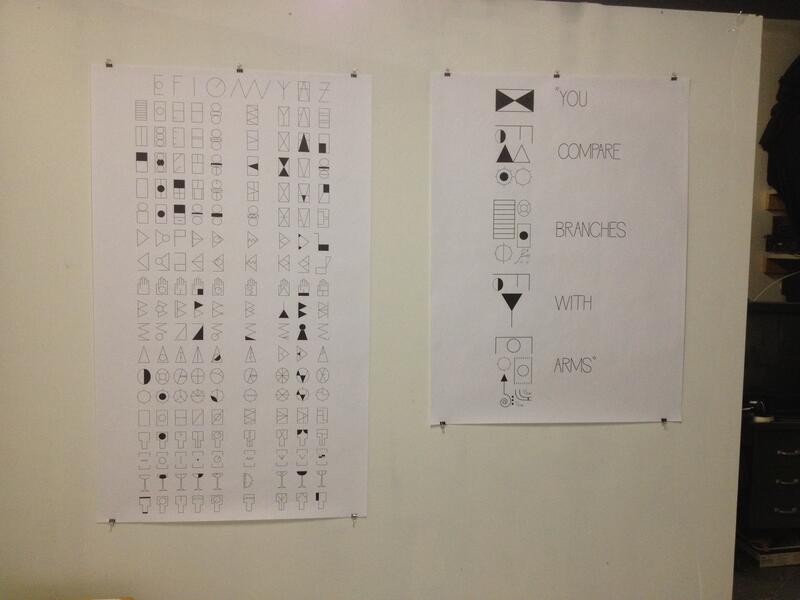 Syllabic System of Sounds Table 1, 2013, print and “You Compare Branches with Arms”, 2013, print
Syllabic System of Sounds Table 1, 2013, print and “You Compare Branches with Arms”, 2013, print -
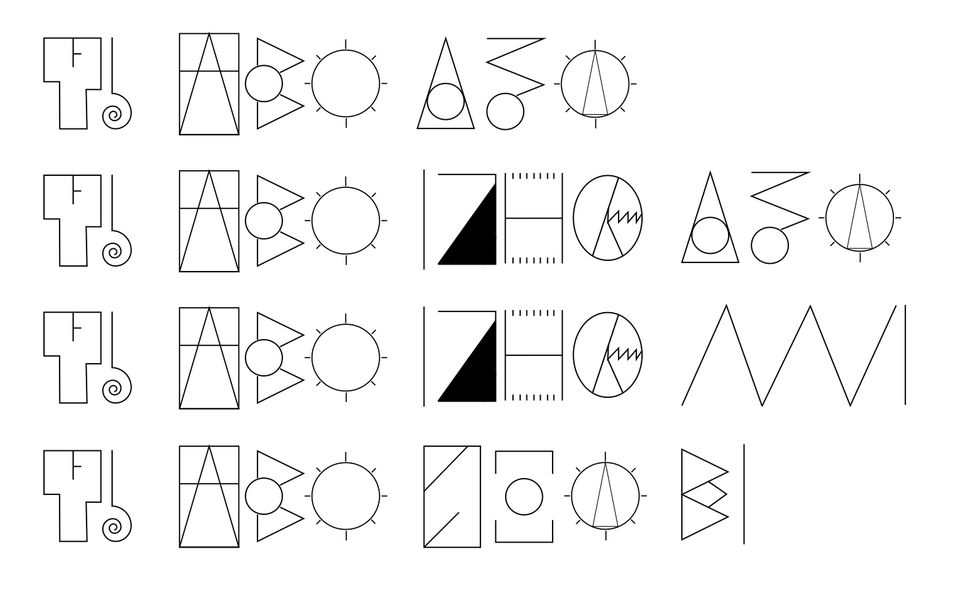 screen-shot-2013-11-22-at-75841-am.png
screen-shot-2013-11-22-at-75841-am.png -
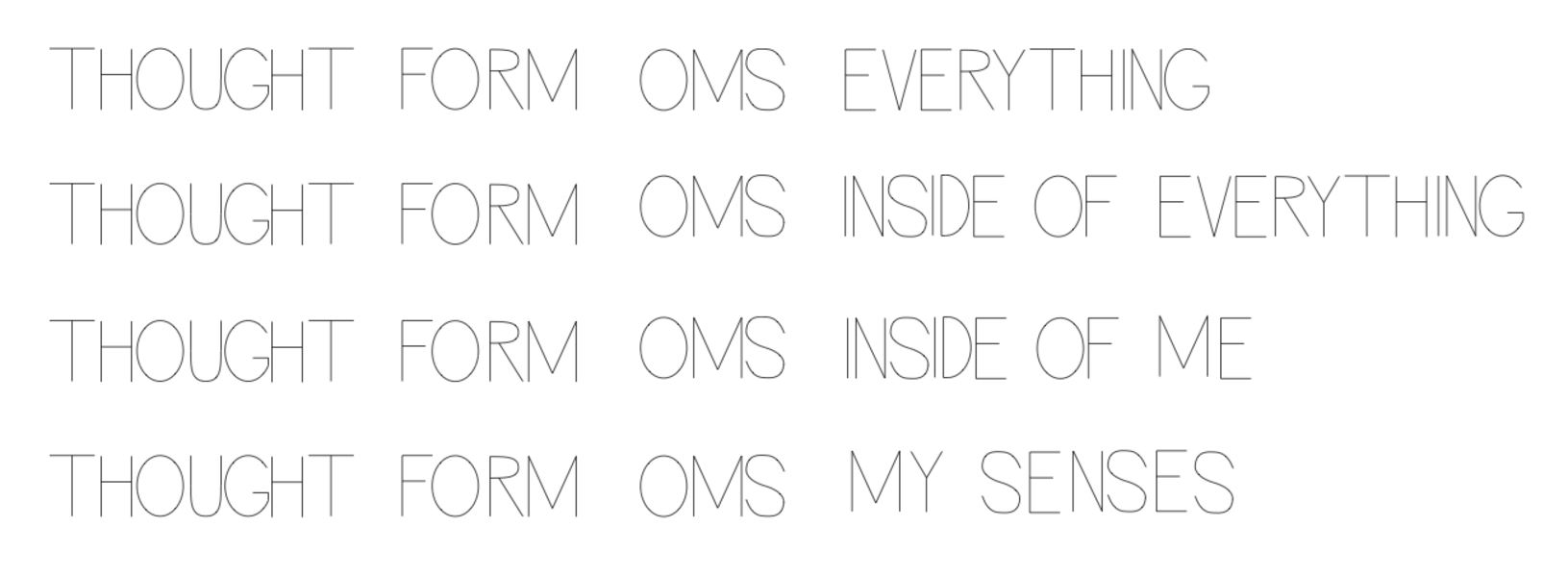 screen-shot-2013-11-22-at-75823-am.png
screen-shot-2013-11-22-at-75823-am.png -
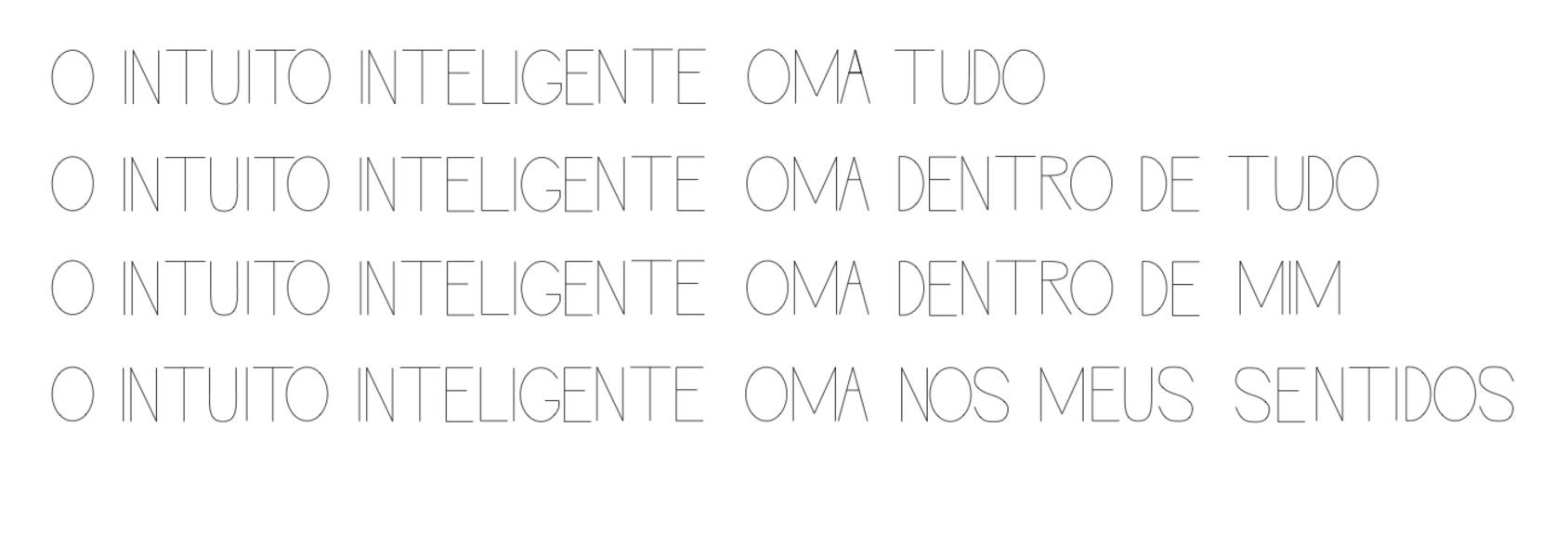 screen-shot-2013-11-22-at-75808-am.png
screen-shot-2013-11-22-at-75808-am.png -
*leikw – Inheritance, Elegant, Election, 2013
-
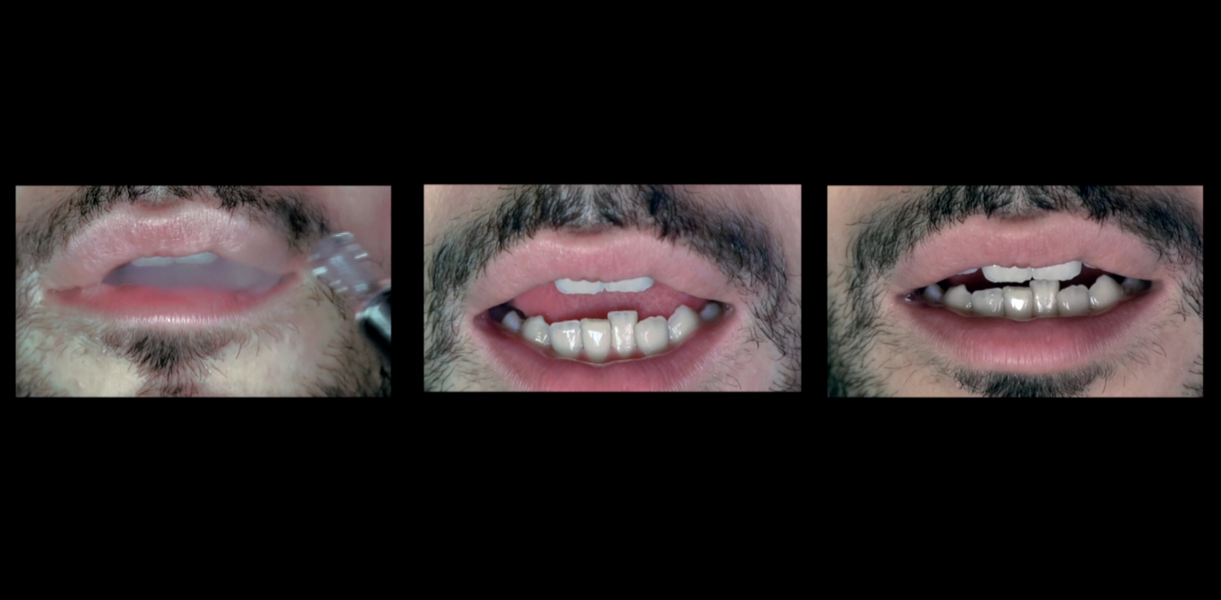 *leikw – Inheritance, Elegant, Election (phonetic connotations series), 2013*leikw — is a video triptych of my mouth reproducing phonemes while exploring the many paths of alliteration by which meaning comes into being. These videos are simulations of the trajectory that phonetics have taken over time through the de/re-contextualizations resulting from human migration. For example, in “Elegant,” I start incessantly repeating the PIE (Proto-Indo-European) word *leikw —. The repetitions quickly morph into eleg- which transforms into the Latin eligere, subsequently transmuting into elegans – elegantis and finally the modern English word “elegant.” *leikw – is the Proto-Indo-European word for “inheritance,” which is phonologically closely related to the Latin root eleg-, meaning choice. In this case, “phonologically related” means that the most distinctive sounds are the liquid alveolar sound l followed by a velar stop kw or g. The piece explores the notion in comparative linguistics that sounds using the same oral muscles or cavities are often interchangeable. These modifications happen due to cultural influences, migrations, linguistic assimilations (i.e., oral translations), and finally genetic mutation. *leikw – is an attempt to illustrate clearly the process used to identify key sound forms in modern languages in order to show how units of sounds that serve as building blocks to the words we use today have pre-determined meanings constructed through a long history. The central purpose of this exercise was the development of a new representation model for language and concepts. Now, you may wonder, what is the connection between “inheritance” and the adjective “elegant”? To answer that question, we must try to transpose ourselves into the environment in which the Proto-Indo-European sounds originated. The experience is purely conceptual by nature, but it does yield a rather clarifying observation: Inheritance comes with privilege, which in turn produces the luxury of choice. In an abundance of choice there's a game or protocol that is cultural by conception. The ability to understand this game and work it, making the “right” choices, becomes a marker of elegance.
*leikw – Inheritance, Elegant, Election (phonetic connotations series), 2013*leikw — is a video triptych of my mouth reproducing phonemes while exploring the many paths of alliteration by which meaning comes into being. These videos are simulations of the trajectory that phonetics have taken over time through the de/re-contextualizations resulting from human migration. For example, in “Elegant,” I start incessantly repeating the PIE (Proto-Indo-European) word *leikw —. The repetitions quickly morph into eleg- which transforms into the Latin eligere, subsequently transmuting into elegans – elegantis and finally the modern English word “elegant.” *leikw – is the Proto-Indo-European word for “inheritance,” which is phonologically closely related to the Latin root eleg-, meaning choice. In this case, “phonologically related” means that the most distinctive sounds are the liquid alveolar sound l followed by a velar stop kw or g. The piece explores the notion in comparative linguistics that sounds using the same oral muscles or cavities are often interchangeable. These modifications happen due to cultural influences, migrations, linguistic assimilations (i.e., oral translations), and finally genetic mutation. *leikw – is an attempt to illustrate clearly the process used to identify key sound forms in modern languages in order to show how units of sounds that serve as building blocks to the words we use today have pre-determined meanings constructed through a long history. The central purpose of this exercise was the development of a new representation model for language and concepts. Now, you may wonder, what is the connection between “inheritance” and the adjective “elegant”? To answer that question, we must try to transpose ourselves into the environment in which the Proto-Indo-European sounds originated. The experience is purely conceptual by nature, but it does yield a rather clarifying observation: Inheritance comes with privilege, which in turn produces the luxury of choice. In an abundance of choice there's a game or protocol that is cultural by conception. The ability to understand this game and work it, making the “right” choices, becomes a marker of elegance.
Freak (Xonian Love)
Freak
20 min solo performance
This work was presented at Mix NYC in November in New York City. The artist started the performance with a series of preparatory physical movements. The physical preparations were followed by used of ecstatic devises, many derived from traditional possession rituals especially Brazilian Espiritismo. The artist then dips his hands in a can of acrylic black paint and writes a text on a 8' by 4' white plexiglass. The text consists of carefully studied symbols that corresponds to phonetic patterns in proto-indo-european, ancient Egyptian, classical Greek, and Sumerian.
20 min solo performance
This work was presented at Mix NYC in November in New York City. The artist started the performance with a series of preparatory physical movements. The physical preparations were followed by used of ecstatic devises, many derived from traditional possession rituals especially Brazilian Espiritismo. The artist then dips his hands in a can of acrylic black paint and writes a text on a 8' by 4' white plexiglass. The text consists of carefully studied symbols that corresponds to phonetic patterns in proto-indo-european, ancient Egyptian, classical Greek, and Sumerian.
Museumfication
Creation of a sacred space through performance and the cutting down of studio walls and exhibiting the parts as artifacts in two galleries.
Auto-mythographic exercise.
The piece was executed in the time span of four months. It was born as a performance piece were I read and opened a pile of mail accumulated from two previous years. Those years were marked by the acquisition of an American Citizenship and financial independence from my parents. These, among many other events, triggered a cascading and seemingly infinite paper trail - documents which to some are quite successful at translating me to better known institutions. The documents were stapled on a studio wall, creating a what struck me as a shrine to the 'translation of the self into representation that is consumable by institutions'. In my own system of associations I call the 'stuff of institutions' 'On' so I was compelled to write an 'ode' to 'On' over the stapled mail.
An intriguing characteristic of institutions is the tendency to periodize an event instantly in the form of a record, document. In this piece I carry that notion through cutting a wall of my studio and transporting it first to Area 405 for a group show and after to EMP collective for another group show. The wall had to be cut in half in order to fit through doors and trucks for transportation. The piece transformed every time it was moved, it's dilapidation makes it almost an archeological relic of layers and layers of W-2's, Bank Statements, Cat's castration, and things of the sort.
Museumfication is more of an experiment with aura asking questions such as: after you remove an architectural element from its context, what remains? After you remove culture, what remains of meaning? To what extent can documents such as W-2's, bank statements, bills, diplomas, accurately describe the individual whom these documents are attempting to encapsulate?
Auto-mythographic exercise.
The piece was executed in the time span of four months. It was born as a performance piece were I read and opened a pile of mail accumulated from two previous years. Those years were marked by the acquisition of an American Citizenship and financial independence from my parents. These, among many other events, triggered a cascading and seemingly infinite paper trail - documents which to some are quite successful at translating me to better known institutions. The documents were stapled on a studio wall, creating a what struck me as a shrine to the 'translation of the self into representation that is consumable by institutions'. In my own system of associations I call the 'stuff of institutions' 'On' so I was compelled to write an 'ode' to 'On' over the stapled mail.
An intriguing characteristic of institutions is the tendency to periodize an event instantly in the form of a record, document. In this piece I carry that notion through cutting a wall of my studio and transporting it first to Area 405 for a group show and after to EMP collective for another group show. The wall had to be cut in half in order to fit through doors and trucks for transportation. The piece transformed every time it was moved, it's dilapidation makes it almost an archeological relic of layers and layers of W-2's, Bank Statements, Cat's castration, and things of the sort.
Museumfication is more of an experiment with aura asking questions such as: after you remove an architectural element from its context, what remains? After you remove culture, what remains of meaning? To what extent can documents such as W-2's, bank statements, bills, diplomas, accurately describe the individual whom these documents are attempting to encapsulate?









